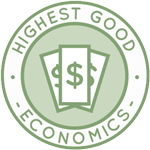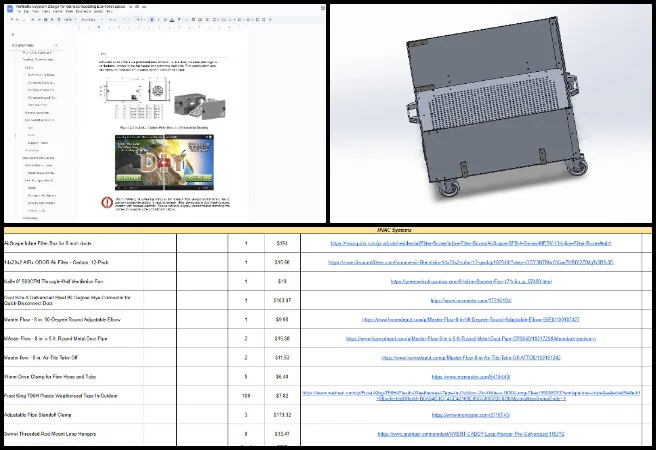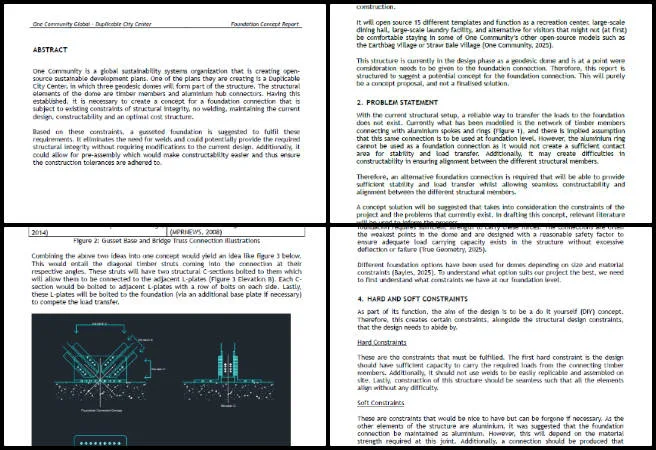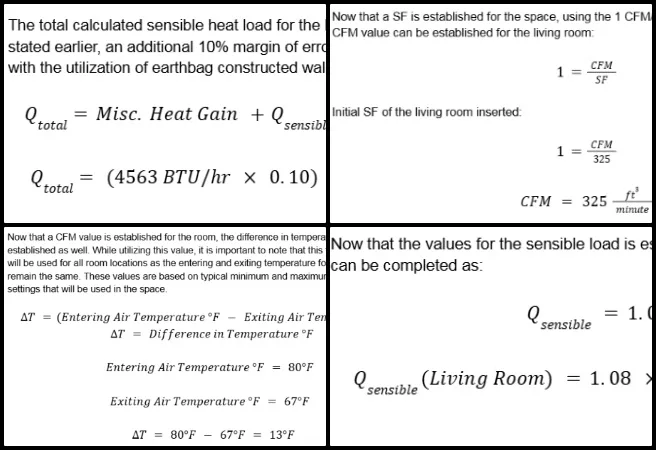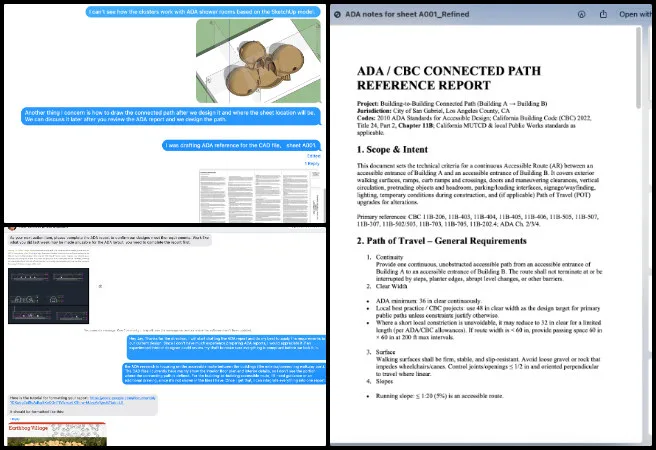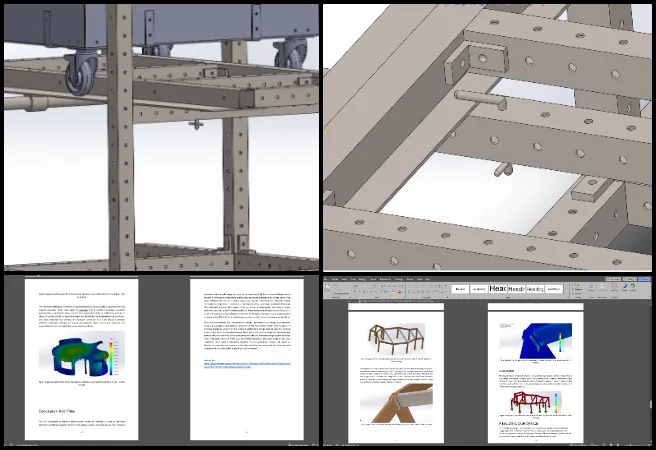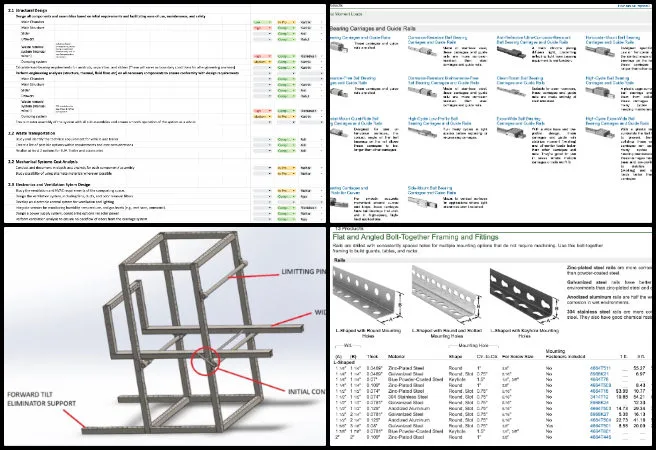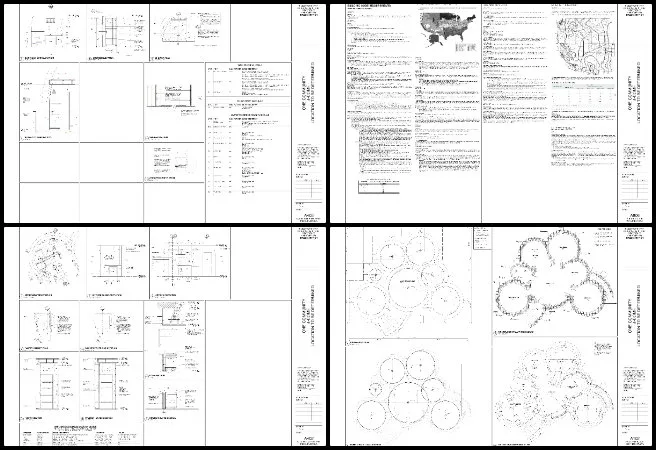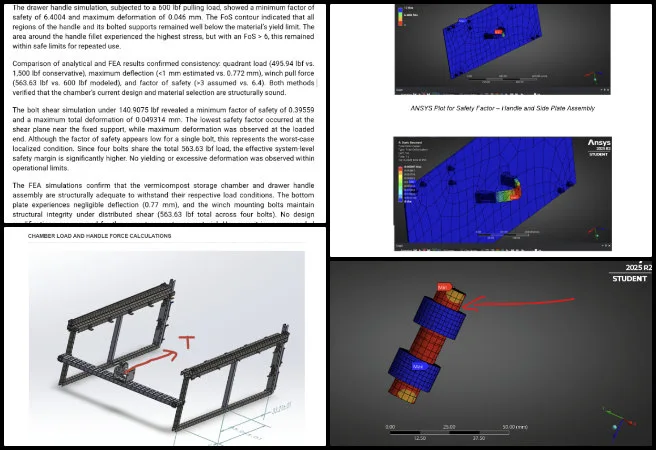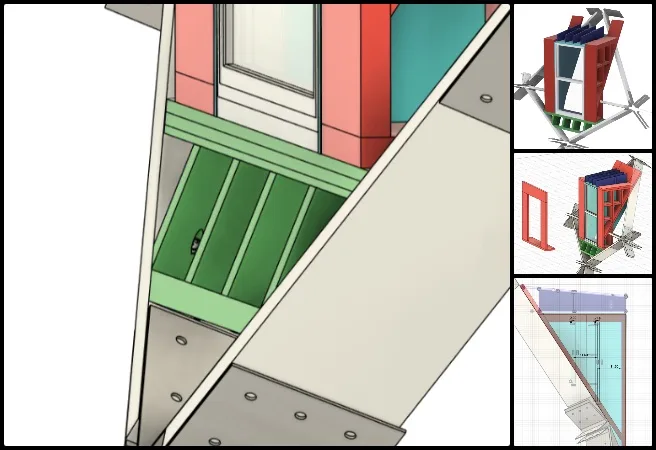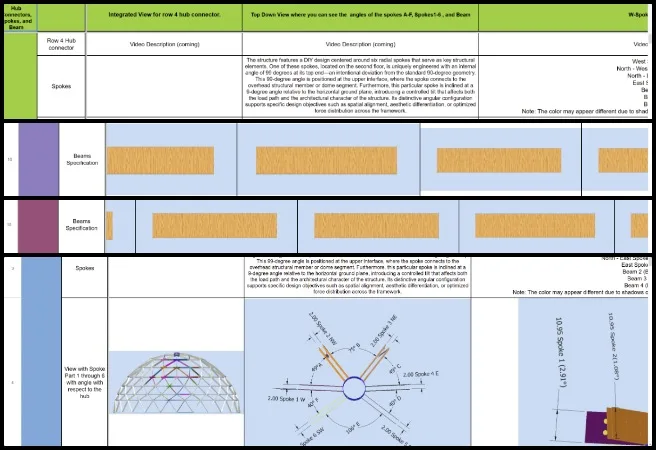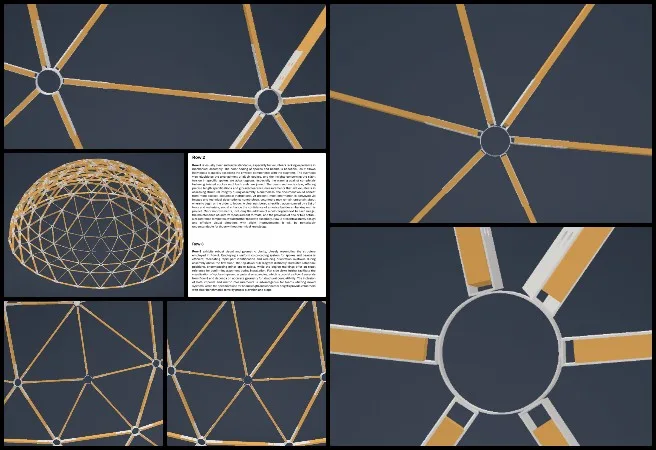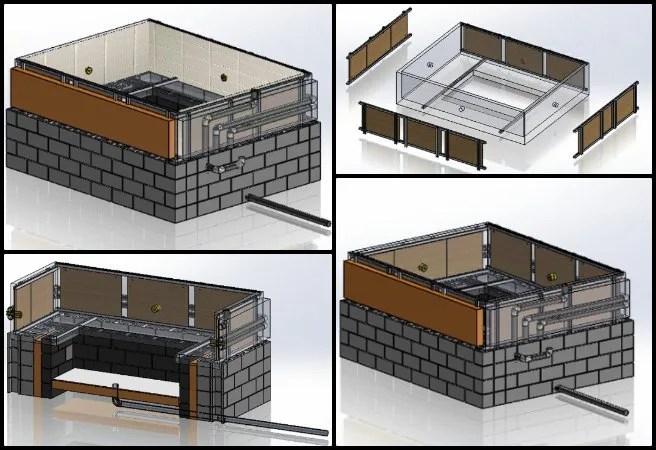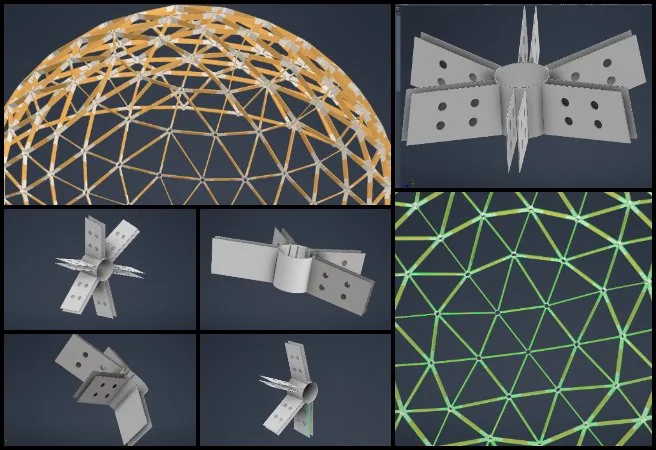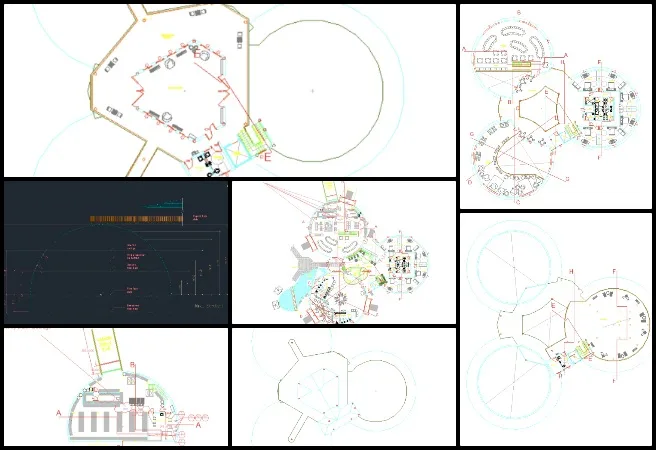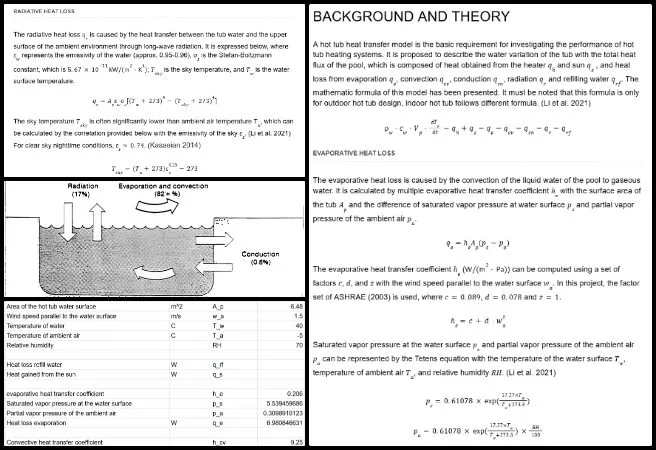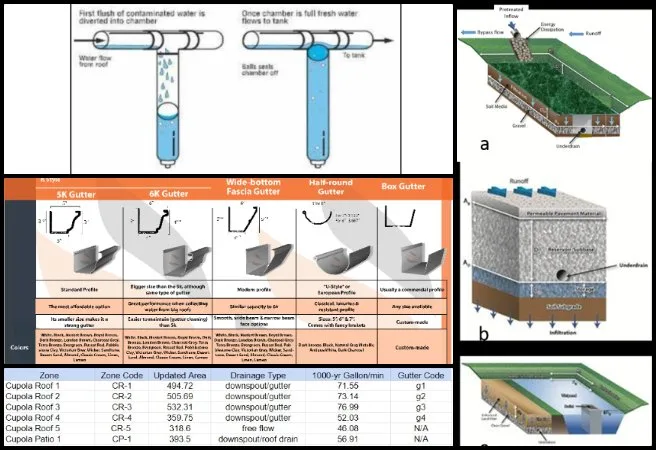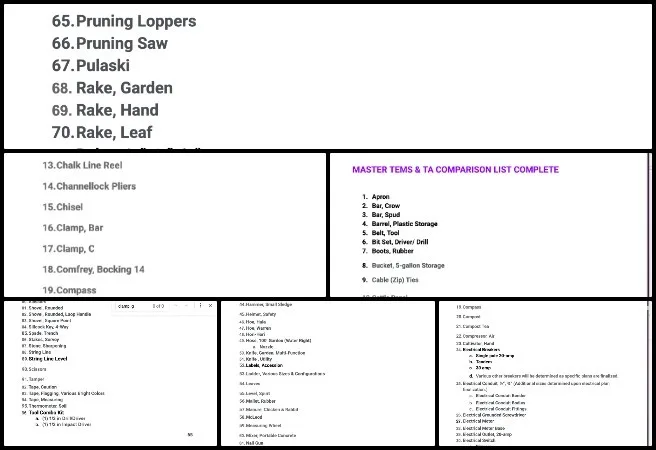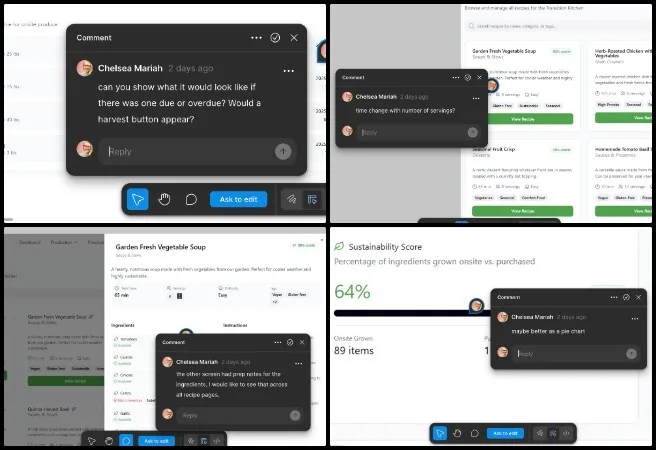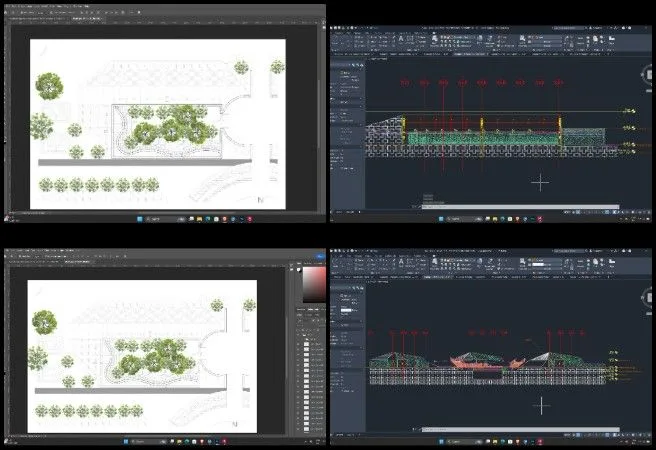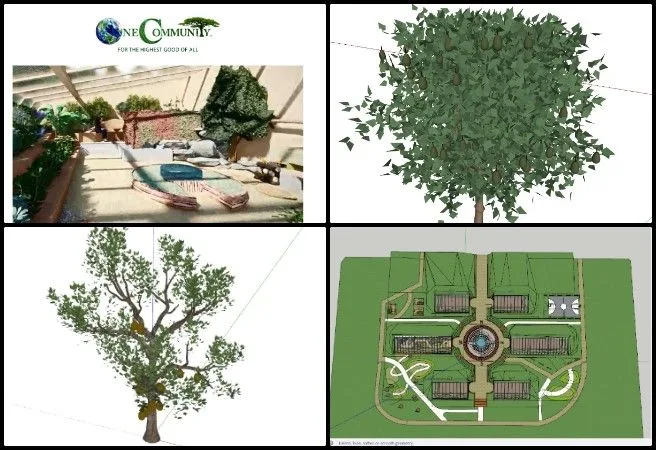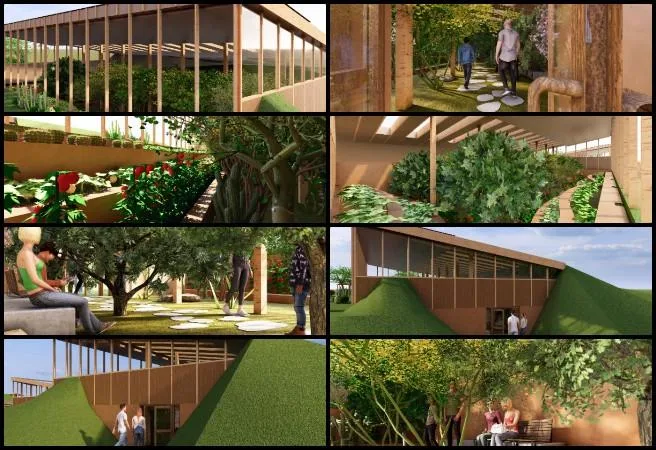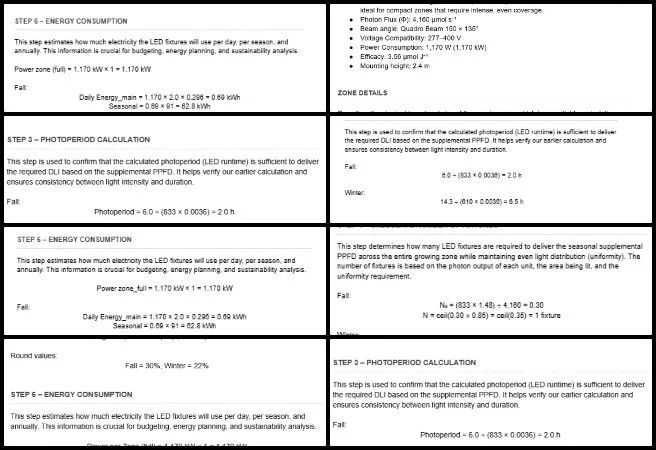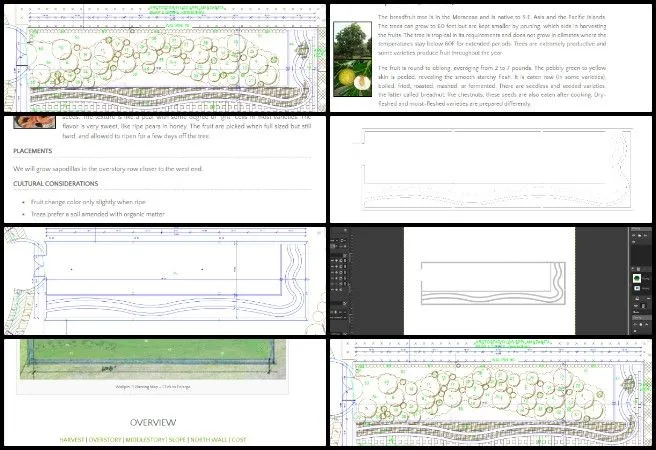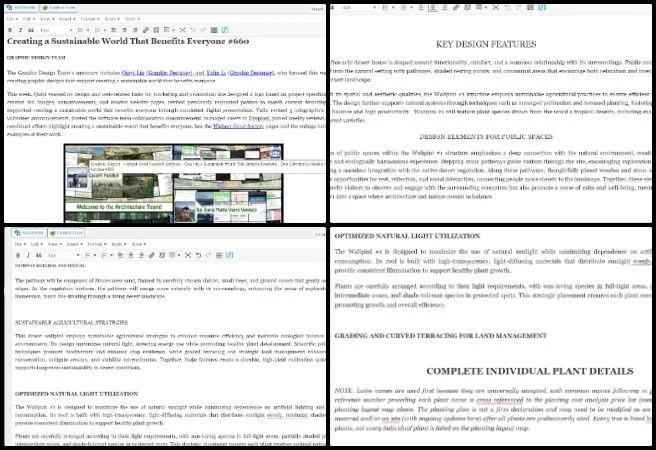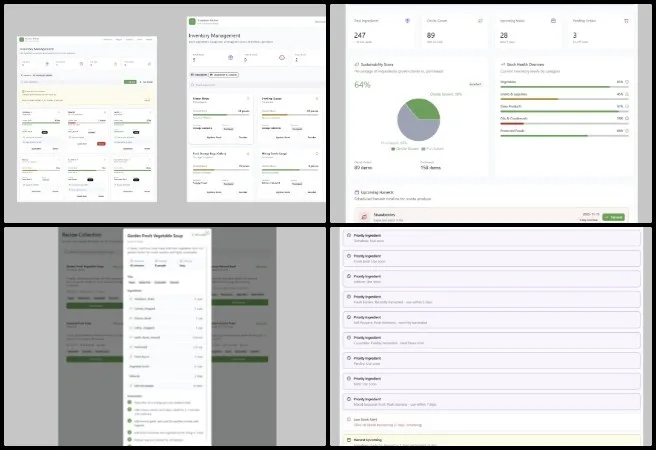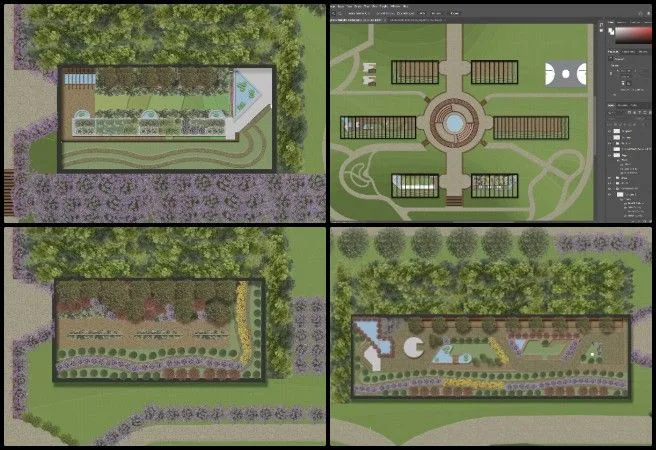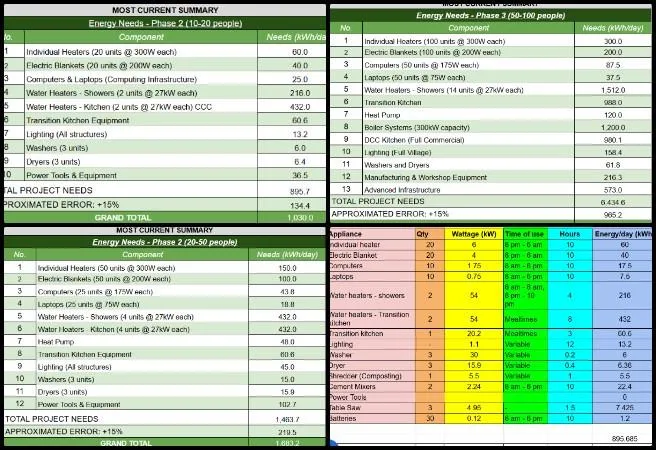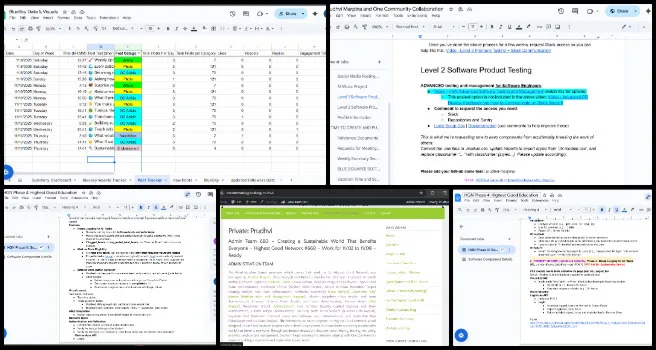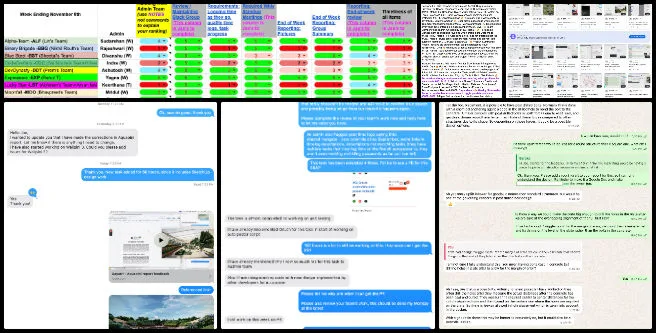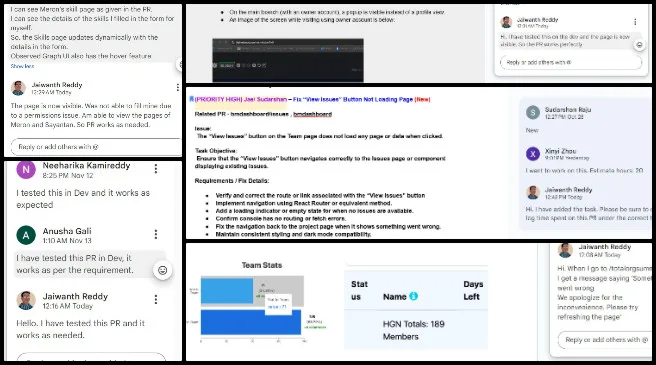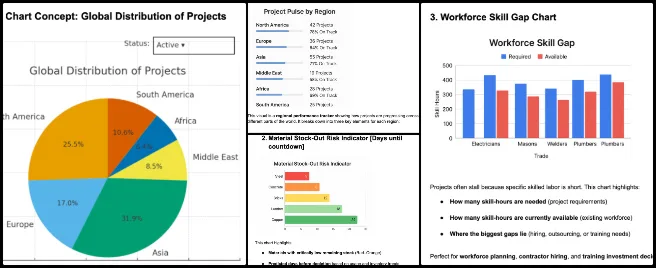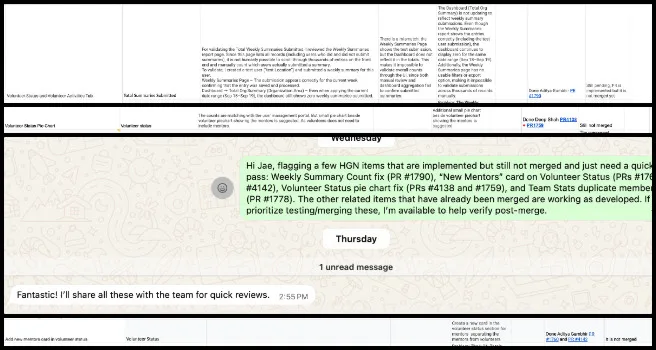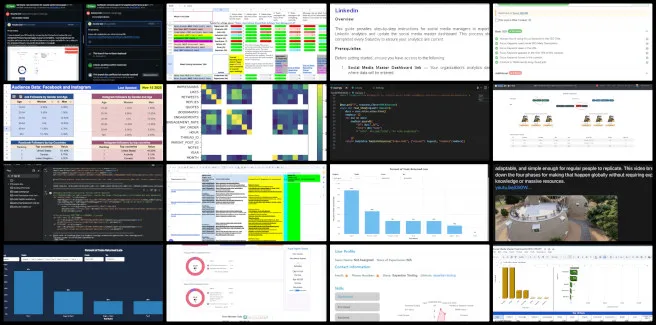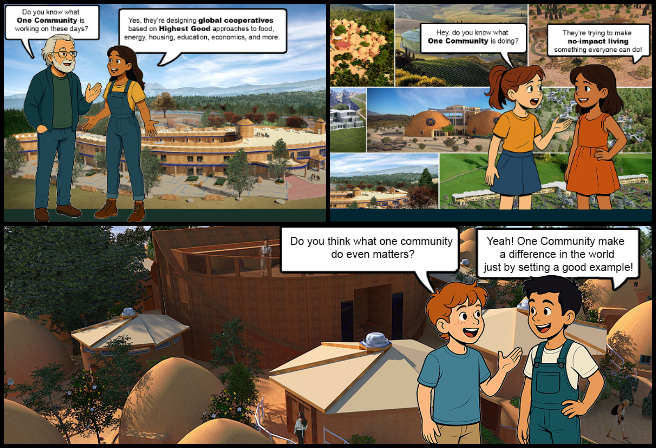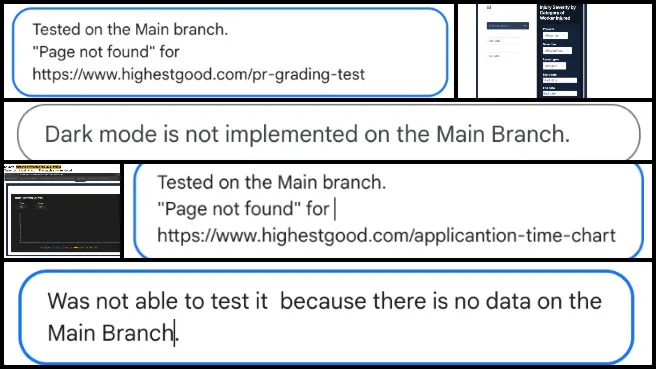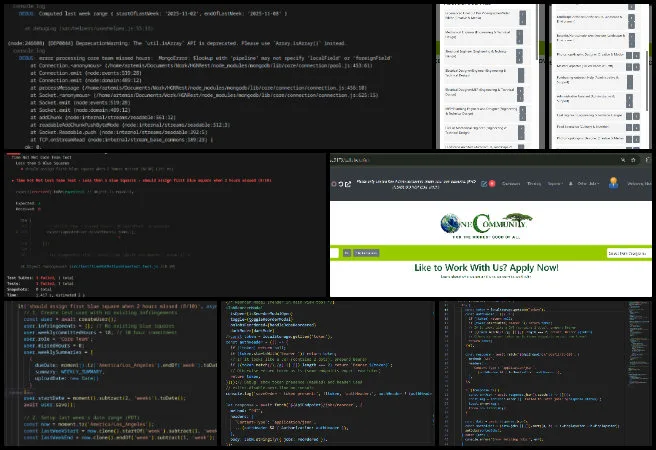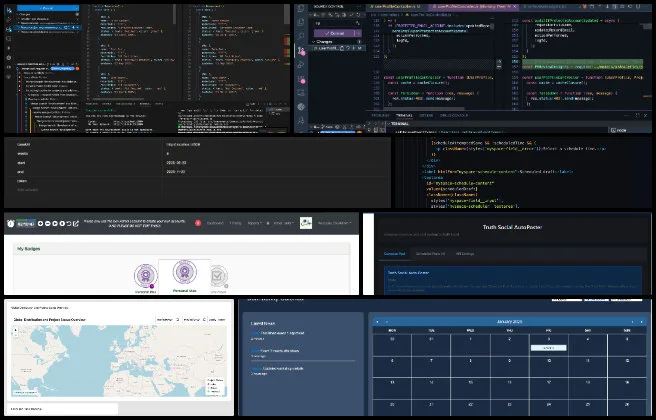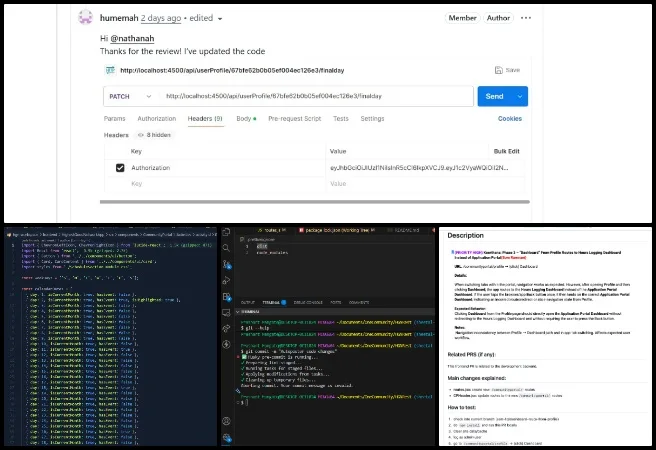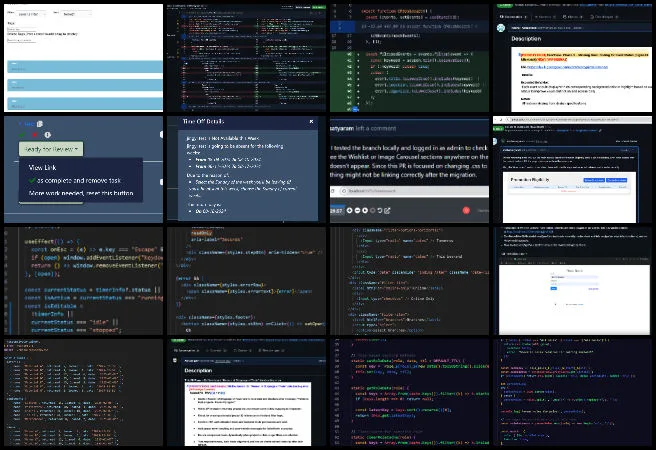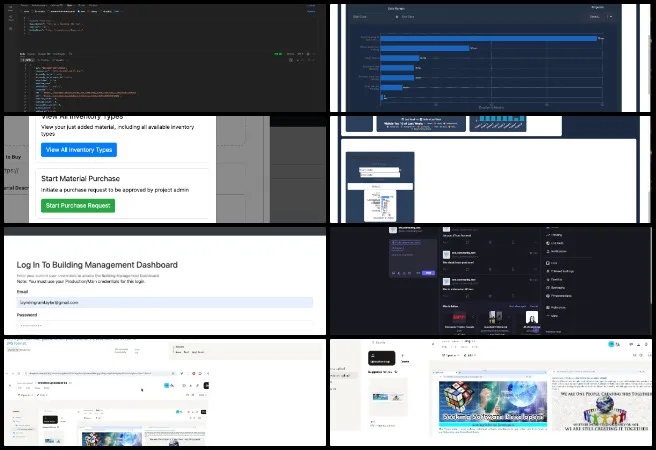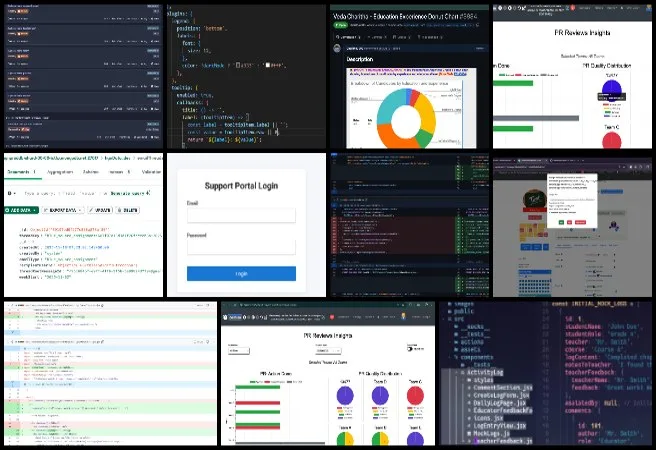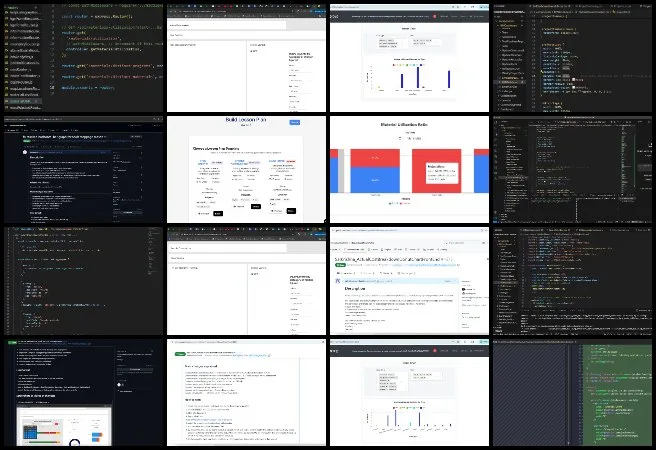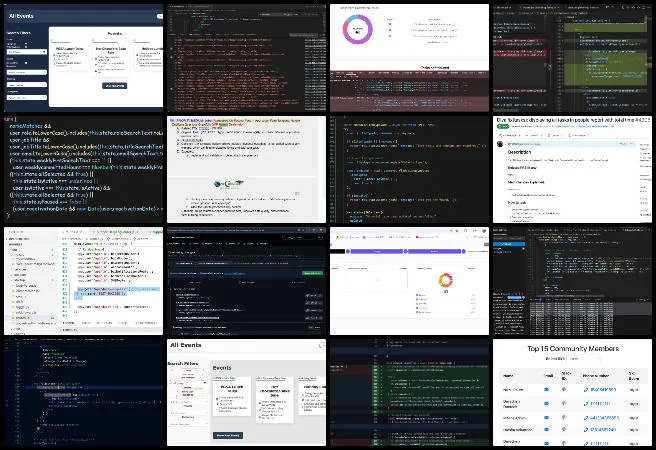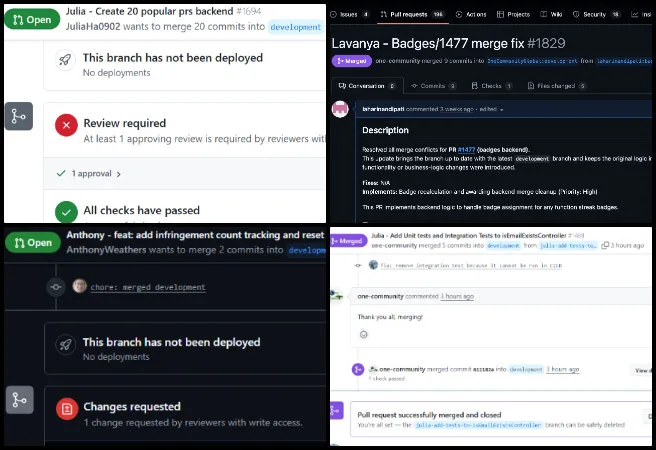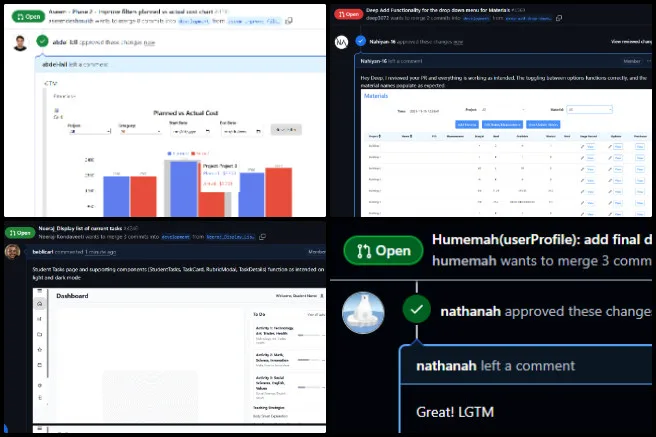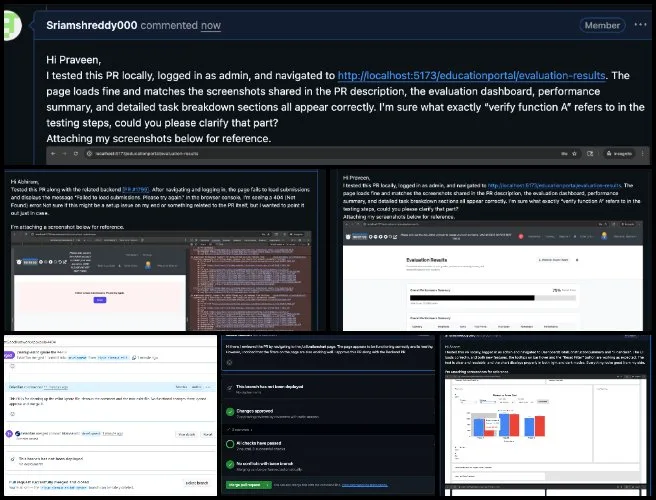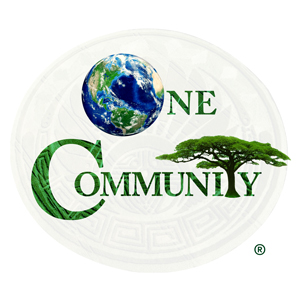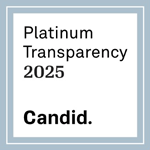
One Community Welcomes Indra Anuraag Gade to the Management Team!
Posted on November 18, 2025 by One Community Hs
One Community welcomes Indra Anuraag Gade to the Management Team as our newest Volunteer/Consultant!
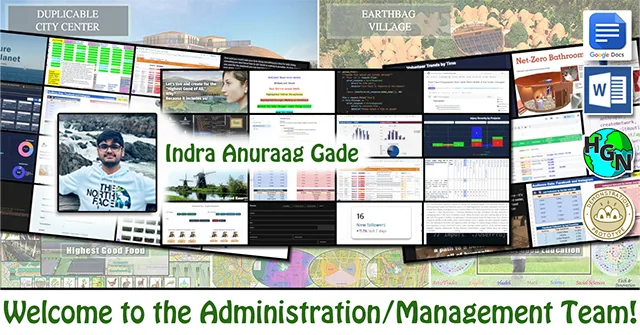
Indra holds a Master’s degree in Computer Science from George Mason University. His professional background includes roles at Agilysys, Inc. and Samsung R&D Institute, where he contributed to projects involving generative models, computer vision, and scalable web applications. As a member of the One Community Admin Team and Highest Good Network Software Team, he conducts functional, UI, and regression testing, supports admin training, and streamlines processes by compiling summaries and editing content for the weekly progress blogs. He has also developed a comprehensive social media analytics dashboard to track engagement and guide strategy for One Community’s X (Twitter) account.
WELCOME TO THE TEAM INDRA!
FOLLOW ONE COMMUNITY’S PROGRESS (click icons for our pages)
INVESTOR PAGES
GET INVOLVED
One Community Welcomes Georgina George to the Management Team!
Posted on November 18, 2025 by One Community Hs
One Community welcomes Georgina George to the Management Team as our newest Volunteer/Consultant!
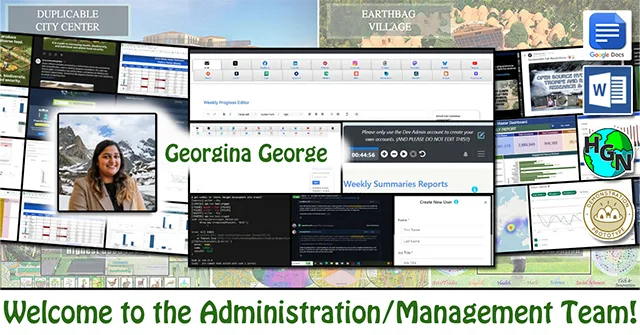
Georgina has over three years of experience in data analytics, reporting, and visualization. She specializes in creating interactive dashboards, automating data workflows, and transforming raw data into actionable insights using tools including Power BI, Tableau, SQL, and Python. Her work focuses on optimizing reporting efficiency, improving data accuracy, and enhancing decision-making through data-driven solutions. Georgina is passionate about sustainability, innovation, and leveraging analytics to support organizational growth. While a member of the One Community team, she contributed to developing and managing the Reddit engagement dashboard, integrating community metrics, and improving the accuracy and visualization of engagement data. She specifically led efforts to implement automated reporting.
WELCOME TO THE TEAM GEORGINA!
FOLLOW ONE COMMUNITY’S PROGRESS (click icons for our pages)
INVESTOR PAGES
GET INVOLVED
One Community Welcomes Sai Suraj Matta Veera Venkata to the Management Team!
Posted on November 17, 2025 by One Community Hs
One Community welcomes Sai Suraj Matta Veera Venkata to the Management Team as our newest Volunteer/Consultant!
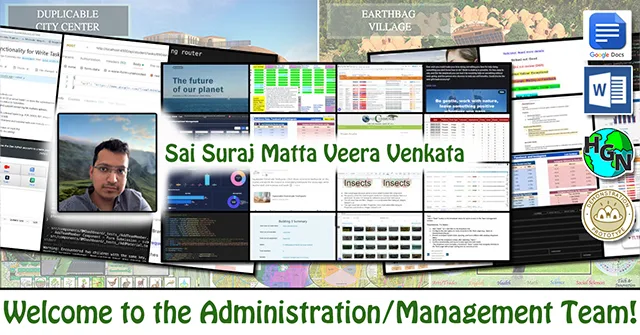
Sai Suraj is a data analyst with proven expertise in designing analytics systems, automating workflows, and translating complex datasets into actionable insights. With strong proficiency in SQL, Python, Power BI, and Tableau, he has successfully implemented multi-platform data integration frameworks and dynamic KPI dashboards across retail, healthcare, and nonprofit domains. He is passionate about leveraging data to improve decision-making, enhance operational efficiency, and drive sustainable impact in collaborative environments. As a member of the One Community team, Suraj has architected a centralized analytics ecosystem consolidating 16+ social media platforms, automated multi-tiered dashboards, and developed a volunteer coordination tracking system that reduced data validation errors by 85%.
WELCOME TO THE TEAM SAI SURAJ!
FOLLOW ONE COMMUNITY’S PROGRESS (click icons for our pages)
INVESTOR PAGES
GET INVOLVED
One Community Welcomes Rajrajeshwari Gangadhar Sangolli to the Management Team!
Posted on November 17, 2025 by One Community Hs
One Community welcomes Rajrajeshwari Gangadhar Sangolli to the Management Team as our newest Volunteer/Consultant!
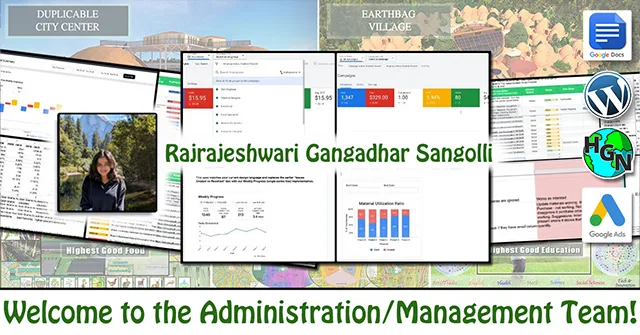
Rajrajeshwari holds a Master’s degree in Business Analytics and Artificial Intelligence and brings 4+ years of experience analyzing large datasets, building dashboards, running A/B tests, and optimizing performance across SaaS, nonprofit, and product environments. Her work spans SQL-based data analysis, automation of operational workflows, predictive modeling in Python, and marketing analytics projects focused on improving conversion efficiency and scaling paid acquisition. As a member of the One Community team, Rajrajeshwari contributes to the Google Ads, Product Testing, and Administrative teams. She leads data-driven ad performance tracking, creates structured testing for the platform, builds visualizations to support development, and identifies issues that guide product improvements.
WELCOME TO THE TEAM RAJRAJESHWARI!
FOLLOW ONE COMMUNITY’S PROGRESS (click icons for our pages)
INVESTOR PAGES
GET INVOLVED
Pragmatic Eco-utopia Creation – One Community Weekly Progress Update #661
Posted on November 17, 2025 by One Community Hs
At One Community, we are pioneering pragmatic eco-utopia creation through sustainable approaches to food, energy, housing, education, economics, social architecture, fulfilled living, and global stewardship practices. Created by an all-volunteer team, we’re developing and open sourcing a self-replicating model designed to help people everywhere build teacher/demonstration hubs working together for The Highest Good of All. By free sharing the complete process and continually evolving sustainability, we aim to empower global collaboration and regenerate our planet while creating a world that works for everyone.
- Here’s our project overview
- Here’s our world-change methodology
- Here’s how this becomes self-replicating
- Here’s how we are open source and free-sharing all the do-it-yourself designs
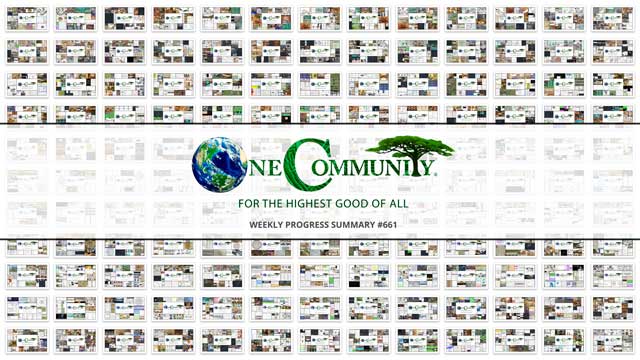
OUR MAIN OPEN SOURCE HUBS
Click on each icon to be taken to the corresponding Highest Good hub page.
One Community’s physical location will forward this movement as the first of many self-replicating teacher/demonstration communities, villages, and cities to be built around the world. This is the November 17, 2025 edition (#661) of our weekly progress update detailing our team’s development and accomplishments:
Pragmatic Eco-utopia Creation
One Community Progress Update #661
DONATE | COLLABORATE | HELP WITH LARGE-SCALE FUNDING
CLICK HERE IF YOU’D LIKE TO RECEIVE AN EMAIL EACH WEEK WHEN WE RELEASE A NEW UPDATE
YOU CAN ALSO JOIN US THROUGH SOCIAL MEDIA
ONE COMMUNITY WEEKLY UPDATE DETAILS
HIGHEST GOOD HOUSING PROGRESS
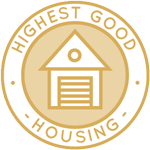 One Community is pioneering pragmatic eco-utopia creation through Highest Good housing that is artistic and beautiful, more affordable, more space efficient, lasts longer, DIY buildable, and constructed with healthy and sustainable materials:
One Community is pioneering pragmatic eco-utopia creation through Highest Good housing that is artistic and beautiful, more affordable, more space efficient, lasts longer, DIY buildable, and constructed with healthy and sustainable materials:
- Learn about: Our Upcoming Crowdfunding Campaign
- Learn about the different village models: 7 Sustainable Village Models
- Visit the open source portals for the first two: Earthbag Village OS Hub | Straw Bale Village OS Hub
This week, Ajay Adithiya Kumar Elancheliyan Tamilalagi (Mechanical Engineer) continued working on the ventilation system design for the Vermiculture Toilet component of the Earthbag Village. He updated the Bill of Materials with the revised item list and totals, added the latest ventilation system and drawer files to shared storage, and created both separate and assembled CAD models for the HVAC system. He made a series of updates to the project report, integrated required design changes into the assembly model, and progressed the assembly setup for further review. Ajay also modified the drawer design based on project requirements and incorporated feedback from Malhar to prepare the updated version for continued work. His ongoing progress supports pragmatic eco-utopia creation through detailed and replicable design work. Below, you’ll find some images of this work.
Baraka Minja (Civil and Environmental Engineer Pr. Eng.) continued working on the Communal Eco-shower and Vermiculture Toilet drawings. This week he worked on a draft report outlining a potential solution for the foundation connection of the Duplicable City Center, proposing a concept involving a bolted connection to the foundation using built-up sections composed of L-shaped and C-shaped channels. The approach was developed to maintain the existing city center design and avoid the need for further modifications or redesign, contributing to pragmatic eco-utopia creation through efficient and adaptable engineering solutions. See below for some of the pictures.
Derrell Brown (Plumbing Designer) continued working on the Earthbag Village 4-dome home final MEP report by reviewing feedback from the initial draft and applying updates across multiple sections. He reviewed the Clarity of Calculations section from the One Community Standards to align the report’s formatting with current expectations. The revisions included updating the HVAC and Sensible Load Logic section to reflect detailed calculations that align with the One Community Guidelines. Derrell also added expanded descriptions alongside these values to maintain clear, chronological order throughout the calculation sequence. His work plays a vital part in pragmatic eco-utopiacreation by ensuring accuracy and transparency in sustainable system documentation. See below for some of the pictures related to this work.
Fangting Xu (Interior Design Intern) continued working with ADA codes related to building connections for ADA 3-dome cluster of the Earthbag Village. This week, she drafted the ADA connected-path notes for sheet A001, clarifying slope, cross-slope, width, ramp, and level-change criteria. She discussed with Jae about the confusion with the ADA shower-room layout. Fangting also tracked Baraka’s weekly tasks and followed up on Ananya’s document handoff to maintain coordination. Her organizational and design efforts contribute to pragmatic eco-utopia creation through accessible and inclusive planning. See below for some of the pictures related to this work.
Karthik Pillai (Mechanical Engineer) continued work on the Vermiculture Toilet and 4-dome home components of the Earthbag Village. This week, he focused on preparing reports for all ongoing projects and moved each task toward completion. He finalized the report for the 4-dome cluster roof project and submitted the design report for Jae to review. Karthik also worked on a combined report for the vermiculture toilet project, covering both the Unistrut assembly and the waste dumping mechanism, with input from the rest of the team. In addition, he designed the final component of the waste dumping mechanism by developing a control pin intended to keep the mechanism stable while the drawer is being loaded. His technical updates and detailed reporting further pragmatic eco-utopia creation through innovation and structural precision. The related visuals are shown below.
Malhar Solanki (Mechanical Engineer) continued working on the Vermiculture Toilet component of the Earthbag Village. This week he focused on updating the bill of materials for the Unistrut assembly, refining the project report, and assisting Karthik with organizing report content, along with participating in the weekly meeting to address any holdups and review task progress; additional work included preparing new tasks and updates for Jae outlining changes in responsibilities for each team member. Malhar’s coordination and documentation efforts play an essential role in pragmatic eco-utopia creation. Review the latest updates in the images below.
Michaela Silva (Architect) continued developing details in the construction documents for the Earthbag Village 4-dome home. This week she updated the earthbag construction sheets to reflect only the four-dome home layout, removing references to the three-dome and six-dome structures. She worked on the materials list and noted the finishes on the interior elevations. Michaela also added the diagrams and tables required for the code requirement sheets, advancing pragmatic eco-utopia creation through clear and replicable architectural documentation. Check out the construction detail visuals below.
DUPLICABLE CITY CENTER PROGRESS
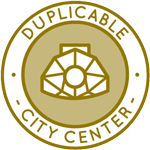 One Community is pioneering pragmatic eco-utopia creation through a Duplicable and Sustainable City Center that is LEED Platinum certified/Sustainable, can feed 200 people at a time, provide laundry for over 300 people, is beautiful, spacious, and saves resources, money, and space:
One Community is pioneering pragmatic eco-utopia creation through a Duplicable and Sustainable City Center that is LEED Platinum certified/Sustainable, can feed 200 people at a time, provide laundry for over 300 people, is beautiful, spacious, and saves resources, money, and space:
- Learn about this building and it’s function: Duplicable City Center Open Source Hub
This week, Andrew Tzu-Chien (Industrial Designer) continued working on the Duplicable City Center Dormer second-floor window. He updated the new window framing within the current 3D model and checked the horizontal and vertical spacing against building safety code requirements. Andrew also reviewed the existing model elements to ensure the updated framing aligned with surrounding structural features and maintained consistency with the project’s established design parameters. This open source Duplicable City Center project demonstrates pioneering pragmatic eco-utopia creation. For more details, refer to the image below.
Ariana Virginia Gutierrez Doria Medina (Industrial Designer) continued working on the Duplicable City Center window and door framing by designing the support structure for the window insulation, which required adjusting several parts and updating the assembly process. She also revised the assembly instructions to reflect those changes while researching material options, estimating costs, and reviewing the basic requirements for the support. This open source Duplicable City Center project demonstrates pioneering pragmatic eco-utopia creation. See the presentation and research highlights below.
Ayushman Dutta (Mechanical Engineer) continued working on the City Center Dome Hub Connector Engineering and DIY manufacturing. He corrected errors in the manufacturing process document and attended a team meeting. He updated the assembly process documents, created organized Dropbox folders with the required images, and formatted the manufacturing document for consistency. Ayushman also reviewed the assembly Excel sheet to confirm that the information was accurate, checked the Row 2 spreadsheet to verify the entries were written correctly, and resolved formatting issues and other details across the assembly spreadsheets. This open source Duplicable City Center project demonstrates pioneering pragmatic eco-utopia creation. Review the connector analysis visuals below for more details.
Bevan Chiu (Mechanical Engineer Volunteer) continued his work finishing the City Center Eco-spa Designs. He updated the CAD model of the rectangular spa tub by measuring key dimensions, adding the inlet and outlet pipes, and including the required fittings. He also developed the CAD model for the rebar that will serve as internal support within the cinder block layer beneath the tub shell. Bevan then integrated the plumbing layout and the rebar structure into the final assembly to ensure alignment between all components. This open source Duplicable City Center project contributes to pioneering pragmatic eco-utopia creation. For more details, refer to the image below.
Koushik Chandra Katta (Mechanical Engineer) continued working on the Duplicable City Center design. He started work on Row 6 and documented the steps needed for the next update based on the progress made. He prepared the assembly needed for the current phase and verified that the components aligned with the expected structure. Koushik also completed the assembly of Row 1, ensuring it matched the earlier specifications. He documented each step to maintain clarity on what remains for Row 6 and how the assembled sections integrate with the broader layout. This open source Duplicable City Center project contributes to pioneering pragmatic eco-utopia creation. See the image below for detailed analysis of this work.
Sandesh Kumawat (Mechanical Engineer) continued developing the City Center Eco-spa Designs. He completed the integrated Hybrid Structure CAD Model for the Eco-Spa project, showing the complete combination of structure, insulation, and plumbing systems. The model incorporates a Unistrut and steel frame for the main load path, supported by a cinder block foundation that provides permanent containment and thermal mass. The cavities between these layers are designed to hold ROCKWOOL batts for high R-value insulation as part of the non-proprietary, sustainable material strategy. The inner shell, made of cork and plywood panels with a cement finish, defines the spa’s form and creates a sealed boundary for waterproofing. Sandesh also defined the plumbing cavities and modeled the initial circulation lines, including return and suction pipes, confirming they fit within the complex geometry. To support serviceability, the design now includes removable access panels framed by the steel structure, allowing easy maintenance of pumps and manifolds, and addressing the repair limitations seen in full-foam spa systems. He then outlined the FEA verification steps, the thermal analysis requirements for the multi-layer wall assembly, and the Bill of Materials items needed for cost estimation and replication documentation. Discover One Community’s open source Duplicable City Center, which exemplifies pioneering pragmatic eco-utopia creation. See the visuals below for a closer look.
Shreyas Nagaraj (Design Engineer) made more updates to the City Center Dome Hub Connector Engineering and beams for the Duplicable City Center. He focused on updates to the Duplicable City Center dome hub connectors and beams, completing model updates for hub connector Row 9 and integrating new hub connector files for Rows 6, 7, 8, and 9 into the overall dome assembly to prepare it for trimming by Koushik. Shreyas then progressed to Row 1, completing the required updates for that row, assembling the Row 1 hub connector into the larger dome model, and providing the updated file to Koushik. This open source Duplicable City Center project exemplifies pioneering pragmatic eco-utopia creation. For more details, refer to the image below.
Srujan Pandya (Mechanical Engineer) continued his work on developing the dynamic simulation setup for earthquake analysis updates for the City Center Dome Hub Connector Engineering. He focused on cross-verifying architectural design documents with the CAD assemblies, ensuring DWG layouts matched the physical components and identifying discrepancies in missing or extra parts. Srujan continued updating the review sheet and ensuring all team members had their tasks and files organized for review. He also revisited the SketchUp models to identify which mezzanine-level components required removal as part of the modifications associated with the FEA work. The Duplicable City Center demonstrates pioneering pragmatic eco-utopia creation through open source solutions that can guide people. The images below illustrate aspects of this work.
Tianxiang Huang (Mechanical Engineer) continued working on the Duplicable City Center design. He focused on heat transfer analysis for the eco-friendly hot tub project, identifying a relevant paper on swimming pool heating technology and converting its information into a usable document. Tianxiang analyzed the heat transfer mechanisms of the hot tub and outlined the key components that influence energy balance, including solar heat gain, evaporation, convection, and radiation. This open source Duplicable City Center project exemplifies pioneering pragmatic eco-utopia creation. For more details, refer to the image below.
Vineela Reddy Pippera Badguna (Mechanical Engineer) continued contributing to the Duplicable City Center Water Catchment designs. She updated the spreadsheet with the latest modifications and reviewed information on rainwater harvesting in cold climates to clarify the necessary details. She added new materials to the report based on the most recent inputs. Vineela also reviewed the website to understand the greywater system and rechecked the calculations to confirm they were accurate and aligned with the current data. This open source Duplicable City Center project contributes to pioneering pragmatic eco-utopia creation. See the updated rainwater catchment data and design visuals below.
HIGHEST GOOD FOOD PROGRESS
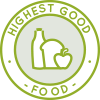 One Community is pioneering pragmatic eco-utopia creation through Highest Good food that is more diverse, more nutritious, locally grown and sustainable, and part of our open source botanical garden model to support and share bio-diversity:
One Community is pioneering pragmatic eco-utopia creation through Highest Good food that is more diverse, more nutritious, locally grown and sustainable, and part of our open source botanical garden model to support and share bio-diversity:
- Learn about the structures: Hoop House Hub | Aquapini & Walipini Open Source Hub
- See what we’ll be growing: Gardens & Hoop Houses | Large-scale Structures | Food Forest | TA
This week, the core team continued working on the Master Tools, Equipment, and Materials and Supplies List for the Large-scale Garden, Botanical Garden, and other Highest Good Food components. Comparisons were conducted between the Master and Rab, Master and Orchard, and Master and Botanical Garden documents. Additionally, cross-comparisons were completed between the Large-scale Garden and Orchard documents, as well as the Orchard and Botanical Garden documents. The Highest Good Food initiative is a key component of One Community’s open source plans, focused on pragmatic eco-utopia creation and exemplifying the organization’s commitment through innovative design and implementation. Below are some images showcasing this work.
Chelsea Mariah Stellmach (Project Manager) continued her new focus on the Transition Food Self-sufficiency food and inventory tracking software plans. She added comments and feedback to Ravikumar’s Figma files to provide a clearer view of expected software behavior, met with Tatyana to gather notes on preferred features for the kitchen inventory software, proposed new designs for additional pages including a hub for managing onsite ingredients such as produce and animal products, and outlined a preference for recipe-style pages for related tasks along with a pie chart for each ingredient to show how it is handled. As an essential aspect of One Community’s open source goals, the Highest Good Food initiative supports pragmatic eco-utopia creation. The following images provide a view of her contributions.
Falguni Sakpal (Volunteer Architectural Designer and Planner) continued initiating render development for the Aquapini and Walipini Master Plan of the Highest Good Food initiative. She worked on the Aquapini and Walipini Master Plan and Related Website Content Updates task. She reviewed the assigned sections across all three main documents. Falguni gathered visual references for the rendering style, studied existing plan and section examples, and reviewed the original AutoCAD base files to understand layer organization and drawing structure. She exported and cleaned the required plan layers, set up the rendering workflow, and began the first draft of the rendered plan. The Highest Good Food initiative is a key part of One Community’s open source platform, focused on sustainable and participatory development while supporting pragmatic eco-utopia creation. See below for pictures related to this work.
Gayatri Pandkar (Architect) continued writing content for the various components of the Aquapini and Walipini aspects of the Highest Good Food initiative. She worked on the Walipini 3 model by sketching initial concepts for the people spaces and exploring layout options to understand circulation and gathering areas. Gayatri gathered and organized the necessary SketchUp plant blocks according to the plan to prepare for the next stage of modeling. She also updated and corrected sections of the Aquapini report, refining descriptions, adjusting terminology, and aligning the content with the latest design approach. The Highest Good Food initiative is a key part of One Community’s open source platform, focused on sustainable and participatory development while supporting pragmatic eco-utopia creation. Visual examples from her work are presented below.
Japneet Kour (Volunteer Architect) continued contributing to the Highest Good Food initiative. She worked on Lumion renders for Walipini #1, the Frost-free Arid Zone Desert House, focusing on defining pathways, plants, trees, and public spaces while confirming that adequate sunlight reaches all intended areas. The work included detailing key design features such as stepping stones for the main pathway, pathway material and texture, natural light use, grading and curved terracing for land management, and the integration of green infrastructure with community spaces. Japneet added people spaces, resting areas, and stone benches that align with the desert walipini environment. She also created an area planned for edible and medicinal plants and a basic walkthrough to accompany the visual layout. The Highest Good Food initiative is a key part of One Community’s open source platform, focused on sustainable and participatory development while supporting pragmatic eco-utopia creation. Visual examples from her work are presented below.
Jay Nair (BIM Designer) continued developing the Aquapini and Walipini Planting and Harvesting documents. He worked on the lighting energy calculations for Greenhouse Walipini 1, updating values and organizing the data to align with the project’s technical requirements. At the same time, Jay continued developing an early concept for a lighting energy calculator that could streamline future calculations, focusing on identifying the inputs, outputs, and structure needed to make the tool practical for repeated use. The Highest Good Food initiative is a key part of One Community’s open source platform, focused on sustainable and participatory development while supporting pragmatic eco-utopia creation. See below for pictures related to this work.
Nitin Parate (Architect) continued contributing to the Aquapini and Walipini renders and layout graphics. Nitin focused on extracting all planting legends from the PSD file and organizing them for reference to support updates to the Walipini layout. The extracted elements were integrated into the plan to improve accuracy and maintain alignment with the updated landscape design. Additional corrections were made to planting layers to match the legend provided by Jae, ensuring consistency in tree types and placements. Work also began on the Walipini 3 plan by reviewing the layout and planting scheme, followed by extracting the required JPGs and PDFs needed for production, rendering, and further development of the plan. The Highest Good Food initiative is a key part of One Community’s open source platform, promoting regenerative and participatory development while supporting the concept of pragmatic eco-utopia creation. Images below showcase his contributions.
Pallavi Deshmukh (Software Engineer) continued working on the Aquapini and Walipini Planting and Harvesting web details. She developed new content for Blog 660, collaborated with her teammates to review input, and integrated feedback to create a consistent final version. Pallavi applied Jae’s feedback, added the Walipini #2 content provided by Silin, and updated the Walipini #2 page with contributions from Junyi Shi. Her updates included revising text, links, and images to align with current project requirements before submitting the revised version for Jae’s review. Pallavi completed the Walipini #2 work and began work on Walipini 1 and Zenapini 2. She also completed three interviews and submitted the related details. In alignment with One Community’s open source objectives, the Highest Good Food project integrates the concept of pragmatic eco-utopia creation into a larger vision of regenerative living. Her contributions are highlighted in the collage below.
Ravi Kumar Sripathi (Software Engineer) continued developing the Food Procurement and Storage software platform, enhancing features related to inventory tracking, recipe management, and food utilization. He refined several interface and functionality updates across the platform with a focus on the kitchen and recipe sections. He defined how due and overdue items should appear and evaluated whether a harvest button should be included for time-sensitive ingredients. Ravi explored alternative data-visualization options, including a pie chart for displaying status information. Within the recipe workflow, he updated the system to adjust cooking time based on the number of servings. He also carried over ingredient prep notes so they appear consistently across all recipe pages. In addition, he added a feature that displays common ingredient substitutions at the top of each recipe. Ravi applied the requested updates on the kitchen page and continued adjusting the design to align with user expectations and the broader layout. The Highest Good Food initiative is a key part of One Community’s open source platform, focused on sustainable and participatory development while supporting the concept of pragmatic eco-utopia creation. See below for pictures related to this work.
Shivangi Varma (Architectural Designer and Planner) continued the redesign of the Highest Good Food overall presentation, currently focused on the Aquapini and Walipini masterplan render. She completed the Aquapini, Walipini, and Zenipini masterplan render, reviewed the feedback received for the graphic, continued developing pending graphics for the HGF Infrastructure, Open Source Hub, and Planting and Harvesting pages with details of the Aquapini, Walipini, and Zenipini structures, and advanced working on the structural differences diagram in particular. The Highest Good Food initiative plays a leading role in One Community’s open source platform by promoting sustainable and participatory development, focused on pragmatic eco-utopia creation. Below are visuals highlighting this work.
HIGHEST GOOD ENERGY PROGRESS
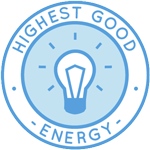 One Community is pioneering pragmatic eco-utopia creation through Highest Good energy that is more sustainable, resilient, supports self-sufficiency and includes solar, wind, hydro and more:
One Community is pioneering pragmatic eco-utopia creation through Highest Good energy that is more sustainable, resilient, supports self-sufficiency and includes solar, wind, hydro and more:
- Learn about the open source sustainable-energy foundations: Solar, Hydro, and Wind
- Explore our research into the most sustainable products and companies for saving water and energy: Insulation, Eco-laundry, Lightbulbs and Light Bulb Companies, Doors and Door Companies, Windows and Window Companies, Toilets, Faucets and Faucet Accessories, Urinals, and more.
This week, the core team continued contributing to the Highest Good Energy initiative. They contacted Vishal, who responded that he would no longer be able to continue working with the team. The team then worked on the energy needs spreadsheet by reviewing several Highest Good Energy documents and linking the energy needs on the summary page to the corresponding values for each project phase. They also added additional energy needs pages from other spreadsheets to the Energy Needs Analysis Spreadsheet and began reviewing and comparing the energy cost analysis against the calculator tool and other related energy cost documents. The Highest Good Energy initiative plays a leading role in One Community’s open source platform by promoting sustainable and participatory development, focused on pragmatic eco-utopia creation. Below are images related to this project.
HIGHEST GOOD EDUCATION PROGRESS
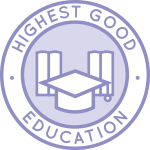 One Community is pioneering pragmatic eco-utopia creation through Highest Good education that is for all ages, applicable in any environment, adaptable to individual needs, far exceeds traditional education standards, and more fun for both the teachers and the students. This component of One Community is about 95% complete with only the Open Source School Licensing and Ultimate Classroom construction and assembly details remaining to be finished. We’ll report on the final two elements to be finished as we develop them. With over 8 years of work invested in the process, the sections below are all complete until we move onto the property and continue the development and open sourcing process with teachers and students – a development process that is built directly into the structure of the education program and everything else we’re creating too:
One Community is pioneering pragmatic eco-utopia creation through Highest Good education that is for all ages, applicable in any environment, adaptable to individual needs, far exceeds traditional education standards, and more fun for both the teachers and the students. This component of One Community is about 95% complete with only the Open Source School Licensing and Ultimate Classroom construction and assembly details remaining to be finished. We’ll report on the final two elements to be finished as we develop them. With over 8 years of work invested in the process, the sections below are all complete until we move onto the property and continue the development and open sourcing process with teachers and students – a development process that is built directly into the structure of the education program and everything else we’re creating too:
- Program Overview: Education Open Source Hub
- How the components work together in designing human orchestrated eco-abundance: How to use the Education for Life Program
- Lesson Plans for Life – Lesson Plans How-to
- Foundations of Outstanding Leaders, Teachers, and Communicators
- Curriculum for Life
- Teaching Strategies for Life
- Learning Tools and Toys for Life
- Evaluation and Evolution
This week, Prudhvi Marpina (Data Analyst) continued developing the Highest Good Education software platform, concentrating on Phase 4: marketing, promotion, and administrative activities. He primarily worked on HGN Phase 4 document tasks, reviewing all action items, checking their corresponding GitHub PR titles, and notifying developers when updates were needed so the titles matched the document requirements. He monitored PRs that were pending for extended periods, communicated with Jae about items requiring high-priority labels, and completed Level 1 and Level 2 testing for multiple PRs, including PR1868 and PR4130. Prudhvi tracked progress on merged and in-review items, verified title consistency across the document and GitHub, and updated developers as needed. In addition to this work, he updated the BlueSky social media tracker sheets, scheduled posts, and completed blog #660, along with reviewing and providing feedback on Administration Team tasks as part of the New-Admin Training Team. Through these activities, he supported One Community’s commitment to pragmatic eco-utopia creation. The images below highlight his contributions.
HIGHEST GOOD SOCIETY PROGRESS
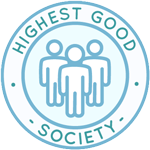 One Community is pioneering pragmatic eco-utopia creation through a Highest Good society approach to living that is founded on fulfilled living, the study of meeting human needs, Community, and making a difference in the world:
One Community is pioneering pragmatic eco-utopia creation through a Highest Good society approach to living that is founded on fulfilled living, the study of meeting human needs, Community, and making a difference in the world:
- Read the Highest Good society overview: Highest Good Society
- Learn about the model for fulfilled living and sharing: A Day in the Life
- Learn about the 4 economic models: RBE | For-profit | Non-profit | Entrepreneurship
- Learn about our open source community collaboration and management software: The Highest Good Network
This week, the core team completed over 44 hours managing volunteer work reviews, handling emails, overseeing social media accounts, supporting web development, identifying new bugs, and integrating bug fixes for the Highest Good Network software. They also interviewed and onboarded new volunteer team members. Additionally, they produced and integrated the video above, highlighting how pragmatic eco-utopia creation serves as the foundation of One Community’s broader mission. The following images showcase highlights of this work.
Jaiwanth Reddy Adavalli (Project Manager) continued developing the Job Applicants page and key components of the Highest Good Network, tracking updates in the software team management documents to assign, monitor, and support task status. He worked on the Phase 1 and Questionnaire Dashboards by testing multiple components in the HGN software. Apart from working on the weekly blog post, as a member of the pull request review team, Jaiwanth reviewed submissions from the volunteer team assigned to him. This work supports One Community’s commitment to pragmatic eco-utopia creation. The images below highlight his contributions.
Rajrajeshwari Gangadhar Sangolli (Data Analyst) continued working on Google Ads management and strategy evolution of the Highest Good Network. She completed steps 1–3, addressed volunteers who did not finish their required hours or submit summaries, created collages, added new links for incoming volunteers, and drafted introductory and closing sentences for them. She completed steps 1–3, addressed volunteers who did not finish their required hours or submit summaries, created collages, added new links for incoming volunteers, and drafted introductory and closing sentences for them. She completed step 4 by adding Bear’s work, checking errors using GPT, and reviewing the work of two volunteers. She finished the weekly analysis, applied Google recommendations, and identified areas for improvement in specific campaigns. Rajrajeshwari designed data charts, tested new PRs, checked for any PRs ready to merge, and tested the dashboard and its dark theme. She created final chart ideations for the dashboard and requested approval from Jae. She added additional chart designs for Jae’s review and reviewed multiple software pages to note suggestions and improvements. She received approval for the designs from Jae, contacted the volunteer as instructed, and incorporated a few more improvements into the chart ideation. This project supports One Community’s commitment to pragmatic eco-utopia creation. The images below highlight key aspects of her work.
Yagna Reddy Badvel (Data Analyst and Team Administrator) continued working on the Summary Dashboards and Weekly Report page on the Highest Good Network. He reviewed and validated the Total Org Summary updates to maintain dashboard accuracy and functionality. Several implemented items were identified as pending merge, including fixes for the Weekly Summary Count (PR #1790), Volunteer Status “New Mentors” card (PRs #1760 and #4142), Volunteer Status pie chart (PRs #4138 and #1759), and Team Stats duplicate member count (PR #1778). Yagna also verified that all merged PRs are working as developed, documented pending items, and drafted a detailed message to Jan summarizing their current status and next steps. Additional work included cross-checking dashboard metrics, validating data consistency, and updating internal tracking sheets. This work supports One Community’s commitment to pragmatic eco-utopia creation. The images below highlight his contributions.
ADMINISTRATION TEAM
The Administration Team’s summary, which covers their work on the Highest Good Network, was managed by Prudhvi Marpina (Data Analyst) and includes Anusha Gali (Software Engineer), Ashutosh Mishra (Software Engineer), Divanshu Bakshi (Team Admin), Indra Anuraag Gade (Software Engineer and Team Administrator), Keerthana Chitturi (System Administrator), Mridul Bhushan (Volunteer Project Strategy Analyst and Team Administrator), Neeharika Kamireddy (Data Analyst), Olawunmi “Ola” Ijisesan (Administrative and Management Support), Olimpia Borgohain (Data Analyst and Team Administrator), Priyanshi Sharma (Data Analyst and Team Administrator), Rachna Malav (Data Analyst), Rajeshwari Bhirud (Administrator), Rishi Sundara (Quality Control Engineer and Team Administrator), Rishitha Adepu (Administrator), Sai Suraj Matta Veera Venkata (Business Data Analyst), Sayantan Paul (Volunteer Frontend Tester and Software Team Administrator), and Sudarshan Raju Chintalapati Venkata (Data Analyst). The Administration Team supports the Highest Good Network, a tool designed to track and measure progress while developing systems that contribute to pragmatic eco-utopia creation. Through administrative support, documentation, testing, training, recruiting, analytics, and content management, the team helps advance this mission, aligning with One Community’s vision of building a replicable and sustainable future model.
This week, Anusha reviewed over fifty pull requests across the HGN and HGNRest systems, checked functionality, identified missing data and loading issues, retested fixes, handled blog updates, reviewed admin posts, prepared collages, and organized submissions for the Duplicable City Center team. Ashutosh completed the 3D avatar interface, prepared a temporary UAT deployment, evaluated fine-tuned models, refined LCEL templates, integrated LCEL chains, built a LangChain Expression Language framework, and updated the chatbot logic with new tests. Divanshu posted four Mastodon updates, documented two action items, updated the Master Dashboard with new analytics, and used Python scripts to extract and structure data. Indra worked on Blog #660 for the Code Crafters Team, created X/Twitter documentation and a walkthrough video, updated analytics dashboards, completed a baseline ML model, added tasks to the Bugs & Features spreadsheet, and continued frontend testing. Keerthana reviewed weekly summaries, updated Step 2 and Step 4 tracking documents, prepared the weekly blog, and added Phase 3 action items. Mridul reviewed Moonfall submissions, refined the team summary, updated HGN Phase 2 documentation, reviewed pull requests, collected missing visuals, and updated his collaborator announcement. Neeharika followed up on task assignments, tested pull requests, completed admin reviews, verified corrections using updated guidance, and conducted an interview. This work supports One Community’s mission of pragmatic eco-utopia creation.
Ola organized folder structures and workspace materials for the admin teams, managed the Pinterest content schedule, generated analytics reports, and submitted her required weekly tasks. Olimpia created LinkedIn analytics training materials and a walkthrough video, updated weekly KPIs, completed senior admin review checks, resolved documentation comments, identified individuals who needed warnings, and scheduled LinkedIn posts. Priyanshi conducted Phase 2 testing, identified chart and filter issues, checked API error handling, and added a high-priority bug linked to multiple PRs. Rachna reviewed older tasks and SEO pages and monitored hiring updates. Rajeshwari completed Blog #660 administration, updated SEO and Binary Brigade content, tested materials and inventory features in the BM Dashboard, and documented pass/fail results. Rishi reviewed Done PRs, followed up with contributors on Slack, checked PRs with merge conflicts, applied high-priority labels, and updated SEO for Blog #660. Rishitha updated bios, uploaded Threads content, added raw data to the dashboard, updated the volunteer tracker, and prepared documentation and videos. Sai Suraj updated Facebook and Instagram analytics, validated and processed new data, maintained data pipelines, prepared training documentation, and completed admin and SEO tasks. Sayantan completed Level 1 testing, continued Level 2 testing on job-posting features, tested PRs addressing access and formatting issues, assigned tasks, and reviewed tracker pages. Sudarshan managed the Alpha Software Team blog, completed SEO updates, reviewed Phase 2 PRs, added new bug and feature tasks, validated dashboard data, and updated BM Dashboard documentation. To learn more about how this work supports One Community’s vision of pragmatic eco-utopia creation, visit the Highest Good Society and Highest Good Network pages. Highlights of the team’s contributions are shown in the collage below.
GRAPHIC DESIGN TEAM
The Graphic Design Team’s summary includes Qinyi Liu (Graphic Designer), who focused this week on creating graphic designs that support pragmatic eco-utopia creation. Qinyi created new characters using ChatGPT, refined them, produced and updated posters, worked on layout, copy editing, and color adjustments for announcements and social media, integrated revised visuals into designs, and incorporated pragmatic eco-utopia creation into the visual focus. She completed these tasks to maintain consistency across project materials. These efforts highlight pragmatic eco-utopia creation. See the Highest Good Society pages and the collage below for examples of their work.
HIGHEST GOOD NETWORK PROGRESS
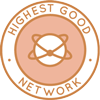 One Community is pioneering pragmatic eco-utopia creation through open source Highest Good Network® software that is a web-based application for collaboration, time tracking, and objective data collection. The purpose of the Highest Good Network is to provide software for internal operations and external cooperation. It is being designed for global use in support of the different countries and communities replicating the One Community sustainable village models and related components.
One Community is pioneering pragmatic eco-utopia creation through open source Highest Good Network® software that is a web-based application for collaboration, time tracking, and objective data collection. The purpose of the Highest Good Network is to provide software for internal operations and external cooperation. It is being designed for global use in support of the different countries and communities replicating the One Community sustainable village models and related components.
- Learn about our open source community collaboration and management software: The Highest Good Network
This week, the core team tested HGN pull requests and confirmed 16 fixed PRs. This effort highlights One Community’s commitment to pragmatic eco-utopia creation. The following PRs were not fixed: making mousing over a task show who created it, donut chart for experience breakdown, adding dark mode styles to the MostFrequentKeywords component, changing .css to .module.css in the PR grading test directory, the inline module CSS bugfix, and the LBDashboard homepage routing and missing routes. Several PRs could not be tested because there was no data on the Main branch, including the suggested jobs list, the Most Frequent Keywords mind map frontend, the job application form, the updated equipment form, and the IssueBreakdownChart module CSS update. The team also had a phone chat with a volunteer about a mockup for the food inventory software. This work strengthens One Community’s mission of pragmatic eco-utopia creation. See the Highest Good Society and The Highest Good Network pages, and the collage below, for an overview of the team’s contributions.
ALPHA SOFTWARE DEVELOPMENT TEAM
The Alpha Software Team, working on the Highest Good Network software, was managed by Lin Khant Htel (Frontend Software Developer). The team includes Maneesh Buddha (Software Developer) and Nikita Kolla (Full Stack Developer). The Highest Good Network software is a key part of sustainable and free-shared eco-solutions, helping track and measure progress toward pioneering pragmatic eco-utopia creation. The software supports social architecture, construction, production, and maintenance processes that contribute to the open source project and resilient ecosystems. Designed to be portable and scalable, the Highest Good Network software is well suited for off-grid and sustainable living communities. This project reflects One Community’s open source commitment to advancing the idea of pioneering pragmatic eco-utopia creation.
This week, Maneesh completed the job posting page update and made the Edit to Reorder feature functional for Owners. His work included reviewing previous implementations, identifying missing components, adding the JobReorderModal.jsx file under the Collaboration folder, restoring modal integration in the main Collaboration view, connecting toggle logic, ensuring proper button visibility based on access level, fixing permission logic, wiring modal actions to the data update flow, and verifying that the reorder workflow can be triggered from the UI. Nikita focused on resolving issues in the test code for the statistics accuracy task by confirming that the functions under test were not modifying the database, creating temporary validation functions, and updating her pull requests by resolving merge conflicts and cleaning up records to align with recent changes. See the Highest Good Society and Highest Good Network pages for more on how this contributed to the idea of pioneering pragmatic eco-utopia creation. See the collage below to view the team’s work.
BINARY BRIGADE SOFTWARE DEVELOPMENT TEAM
The Binary Brigade Team, presenting their work on the Highest Good Network software, was managed by Nikhil Routh (Software Engineer) and included Kanishk Agarwal (Software Engineer), Apoorva Jain Ramapura Prashanth (Software Engineer), Ramsundar Konety Govindarajan (Software Engineer), Harsha Rudhraraju (Software Engineer), Xinyi Zhou (Developer), Sourabh Bagde (Software Developer), Taariq Mansurie (Full-Stack Developer), Sumedh Kumar (Full-Stack Developer), Aswin “Tony” Kanikairaj (Software Engineer), and Amalesh Arivanan (Software Engineer). The Highest Good Network software is our tool for managing and objectively measuring progress, ensuring that all contributions are tracked and aligned with our mission, modeling, and pioneering pragmatic eco-utopia creation.
This week, Amalesh implemented the Phase 2 Summary Dashboard by creating a KPI tile view and a weekly task line chart with 4-, 8-, and 12-week filters, adding date validation, building backend endpoints for weekly grouping and KPI aggregation, applying timezone handling, and documenting all work in Dropbox. This work strengthens One Community’s dedication to pragmatic eco-utopia creation. Apoorva worked on the Truth Social auto-poster integration and completed five UI improvements for the email subscription system, including clearer success messages, proper error indicators, loading spinners, responsive logo behavior, and enhanced accessibility. She also developed additional UI updates such as semantic labels, disabled button states, and improved error presentation. This work plays a role in One Community’s approach to pragmatic eco-utopia creation. Aswin completed the Phase 4 Badge Tracking Page by building the badge gallery, modal, badge components, CSS module styling, setting up mock data, refining the layout, and then pushing the changes with supporting documentation. Harshavarma set up the frontend branch, analyzed requirements, and built the graph component with date and role filters, custom Y-axis labels, actions, reducers, Recharts integration, dark mode alignment, error handling, and frontend-backend synchronization. Kanishk extended the community portal calendar by refining the Phase 3 UI, syncing selected dates with filters, applying modular styling, and then working on Phase 3 attendance tracking by documenting schema and API contracts, building CRUD services with mock data, and completing the attendance logging frontend with sortable tables, analytics, visualizations, and modular CSS. This work adds to One Community’s efforts toward pragmatic eco-utopia creation.
Nikhil continued the CSS Modules migration across Community Portal, BM Dashboard, and Teams by converting remaining files, updating imports, coordinating team progress, reviewing related pull requests, validating backend fixes for MongoDB timeout issues and defining database requirements for a new backend feature with a team member. This contribution advances One Community’s vision for pragmatic eco-utopia creation. Ram worked on the PR Review Analytics Dashboard by identifying missing PR-only teams in the filter, determining mismatches between UserProfile and PRReviewInsights collections, adding a parameter to return PR teams only when needed, and ensuring the dashboard now includes all relevant teams without affecting other pages. Sourabh advanced the MySpace auto-poster module by building the posting and scheduling workflow, adding validation, creating a two-column layout with responsive styling, implementing saved-post cards, enabling edit-flow hydration, and integrating toast feedback across actions. This work adds to One Community’s efforts toward pragmatic eco-utopia creation. Sumedh developed the new Material Usage Record chart for the BMDashboard by building a React component with a Recharts doughnut chart inside a modal, integrating data from the Material List page, and identifying remaining styling and responsiveness improvements. This contribution helps reinforce One Community’s pursuit of pragmatic eco-utopia creation. Taariq addressed bugs, merge conflicts, and test failures across multiple repositories, fixed filter behavior on refresh, resolved yarn file discrepancies, updated the archived projects feature, refined elements of the Phase 4 Assign Lesson Plan feature, progressed on the weekly summary email task, and cleaned up unused code. Xinyi resolved issue-related navigation problems by adding missing handlers, fixing dropdown behavior, correcting the “View Issues” route on the Team page, adding loading and empty states, validating error handling, and ensuring consistent styling across light and dark modes. See the Highest Good Society and Highest Good Network pages for more information on how this work models pioneering pragmatic eco-utopia creation. The collage below shows images of their work.
BLUE STEEL SOFTWARE DEVELOPMENT TEAM
The Blue Steel Software Team, working on the Highest Good Network software, was managed by Divanshu Bakshi (Product Manager) and includes Linh Huynh (Software Engineer), Humemah Khalid (Software Engineer/Backend Developer), Som Ramnani (Software Engineer), and Sheetal Mangate (Software Engineer). The Highest Good Network software is how we’ll manage and objectively measure our progress in pragmatic eco-utopia creation through our social architecture, construction, production, and maintenance efforts, while supporting widespread and lasting eco-lifestyle access.
This week, Humemah worked on adjusting permissions related to the “set final day” action to ensure rules applied correctly and added date validation to the infringement creation process in the userProfileController. She inserted checks for required and optional dates so that invalid or empty values return a 400 response and valid dates are stored in ISO format. Pioneering pragmatic eco-utopia creation remained the guiding context as work continued across permissions, development, routing, and testing. Linh completed development of the Event Management Page in the Organizer View as part of the Phase 3 task. He finalized the page structure under the correct route, removed outdated components, and built the new Event Page Organizer structure. He integrated the page with the mock API to support dynamic loading and updating of event details, including description, status, rating, and date selection using activityId-based localStorage. He also refined the component layout, improved CSS module isolation, addressed build and dependency issues with Tailwind and ESLint, resolved rendering and data synchronization bugs, and verified UI alignment across multiple sections, including Description, Analysis, Resource, and Engagement. The functionality of the date selector, calendar integration, and media upload features was confirmed. This work is part of One Community’s framework for pragmatic eco-utopia creation.
Som worked on PR 4334 and PR 4383 related to Community Portal routing. For PR 4334, he updated user-related navigation so that profile, view profile, and update password routes function within the Community Portal namespace and added CPProtectedRoute entries to support authentication and authorization logic. For PR 4383, he updated routing so that navigation elements under Other Links remain within the Community Portal namespace, added route definitions for User Management, Projects, Teams, Announcements, Badge Management, and Permissions Management with role-based access control, and configured the related repository. Sheetal worked on unit tests for add, edit, and delete scheduled task functions and the bulk submit scheduled post endpoint. She made backend updates and resolved frontend issues where failing tests blocked commits by creating a new local branch and merging code into it to isolate the cause. This aligns her work with the long-term goals of pioneering pragmatic eco-utopia creation. The collage below shows images of their work.
CODE CRAFTERS SOFTWARE DEVELOPMENT TEAM
The Code Crafters Team, covering their work on the Highest Good Network software, was managed by Vivek Chandra (Software Engineer) and includes Ajay Naidu (Software Engineer), Akshith Kumar Reddy Balappagari Gnaneswara (Software Engineer – Full Stack), Chaitanya Swaroop Kumar Allu (Software Engineer), Juhitha Reddy Penumalli (Software Engineer), Sanjeev Raichur (Software Engineer), Shradha Bhadrannavar (Software Engineer), Sphurthy Satish (Software Engineer). The Highest Good Network software is how we’ll manage and objectively measure our progress in pragmatic eco-utopia creation through our social architecture, construction, production, and maintenance efforts, while supporting widespread and lasting eco-lifestyle access.
This week, Ajay advanced Phase 2 of the Summary Dashboard by implementing a line chart for tracking rental costs, resolving layout and dark-mode styling issues, and migrating styles to CSS Modules for better scoping. Akshith progressed Phase 4 of the PM Educator Training Dashboard by setting up the frontend structure, creating components and styling files, validating functionality with mock data, and beginning backend integration. Chaitanya strengthened the MailChimp Replacement pipeline by refining email-sending logic to meet Gmail rate limits, modularizing backend components, replacing the cron-job scheduler with an in-memory queue, improving send sequencing, and adding controller documentation. These efforts collectively support One Community’s pragmatic eco-utopia creation goals. Juhitha continued Phase 4 of the Task Progress Indicator by completing the donut chart and progress bars, linking dashboard navigation, updating styling, fixing CSS issues, preparing PRs, resolving merge conflicts and test errors, addressing Notify app triggers, reviewing SonarQube findings, and finalizing integration steps for the POST endpoint that updates task completion status.
Sanjeev added event-creation capabilities to the Community Portal by introducing a Redux action for POST requests, creating a modal interface for entering event details, integrating it into the UI with state management and handlers, and providing testing steps to verify backend communication. Shradha validated issues from PR #3263 while reviewing PRs #3668 and #1476 by testing reports across all scenarios, confirming that rendering, spacing, dark-mode readability, and error handling behaved correctly, documenting results with screenshots, and planning a final verification pass. Sphurthy expanded analytics in the HGNRest application by creating the StudentMetrics model, building a service to compute engagement metrics from form responses, adding two analytics endpoints, and implementing a scheduled job that updates metrics daily while aligning all changes with existing Express, Mongoose, and node-cron patterns. Vivek met with his transitioning manager to review handoff tasks, examined the responsibilities he will assume, reviewed PRs 4152, 1769, 3469, and 1379, requested changes where functionality failed, and spent time learning expectations for his new managerial role. These contributions strengthen One Community’s mission and commitment to advancing pragmatic eco-utopia creation. The collage below shows an overview of this team’s work.
DEV DYNASTY SOFTWARE DEVELOPMENT TEAM
The Dev Dynasty Team’s summary, covering their work on the Highest Good Network software, was managed by Prem Vora (Software Developer) and includes Adithya Cherukuri (Volunteer Software Engineer), Aditya Gambhir (Software Engineer), Deekshith Kumar Singirikonda (Developer), Manvitha Yeeli (Software Engineer), Mohan Satya Ram Sara (Software Engineer), Nahiyan Ahmed (Full-Stack Software Developer), Neeraj Kondaveeti (Software Engineer) and Vamsidhar Panithi (Software Engineer). The Highest Good Network software is how we’ll manage and objectively measure our processes for open sourcing a better world for us all through our social architecture, construction, production, and maintenance processes. This progress supports One Community in pioneering pragmatic eco-utopia creation.
This week, Nahiyan reviewed PR 4369 by checking the material toggling feature, confirming that material names populated correctly for different options, validating workflow logic, ensuring interaction stability during testing, and reviewing code structure for consistency. Adithya worked on backend development for the Job Posting Analytics role-based visualization feature by extending aggregation logic from two-role to multi-role pairing, adding a ten-minute caching system for the GET/Timeline route, finalizing endpoints, integrating functionality, and reviewing project image documentation. Aditya enhanced the Reason of Stoppage of Tools feature by adding and testing backend endpoints, identifying inconsistent error responses and redundant validations, building the ToolsStoppageHorizontalBarChart using Chart.js with project auto-selection, date range filters, dark mode support, refactoring related charts for responsive behavior, maintaining backend validation, indexing, caching, structured responses, and preparing documentation describing changes and test steps. Deekshith worked on a React-based analytics and user management setup by creating a PermissionWatcher component to monitor authentication and permission changes using React-Redux and Axios, triggering timed logouts, defining event-related data structures for analytics, and developing an AttendanceStatistics component with interactive charts and month-based state management.
Manvitha built the student timer feature by connecting frontend to backend, resolving path, JSON, and header issues, adding backend components for start, pause, resume, stop, status, history, and duration changes, redesigning the timer into a compact display with an expanded popup, and fixing timing and synchronization issues. Mohan reviewed multiple frontend pull requests by testing chart filters, tooltips, reset actions, styling updates, dashboard behavior, UI pages, questionnaire functionality, and permission management changes, documenting layout issues and dark mode inconsistencies, and validating endpoints and automated tests. Neeraj worked on event-related frontend updates by adding a missing Search Events input, applying color coding for event statuses, and adding status badges such as New, Needs Attendees, Filling Fast, and Full, updating UI components to match design requirements. Prem focused on event filtering and date validation by testing upcoming events, adding logic to prevent past date selection, and creating corresponding pull requests. Vamsidhar optimized dark mode behavior and UI consistency across BM Dashboard modules, resolving background and text inconsistencies, refactoring CSS and component conditions, fixing layout issues during theme transitions, and validating user preference persistence. See the Highest Good Society and Highest Good Network pages for more on how this relates to our mission of pioneering pragmatic eco-utopia creation. Explore some of the team’s work in the collage below.
EXPRESSERS SOFTWARE DEVELOPMENT TEAM
The Expressers Team’s summary, which covers their work on the Highest Good Network, was managed by Rahul Trivedi (Software Engineer) and includes Layne Taylor (Software Engineer), and Meenashi Jeyanthinatha (Full-Stack Developer). This contribution supports One Community’s goal of pragmatic eco-utopia creation.
This week, Layne focused on frontend modals to accommodate the search and add materials feature, as well as SKU and QR code generation. She spent about half of her time drafting and editing correspondences with Jae and Ujjwal about the task’s new direction. Layne organized the SKU implementation plan, communicated it with Jae before coding, and addressed decisions about state management within the existing code base. She updated the “Add Material” button to “Search Material,” opening a modal to display existing materials or provide an “Add Material” option when needed. She also added SKU and QR code generator placeholders on the Add Material form, considering future options for a separate modal or conditional rendering. This work aligns with One Community’s ongoing efforts in pragmatic eco-utopia creation. Layne plans to work on the backend portion next, and the code will remain consistent with the video uploaded on Friday.
Meenashi retrieved the accessToken, clientId, and clientSecret but encountered an error when calling the API to obtain the refreshToken and is awaiting guidance. She also improved Dropbox integration error handling by correcting expired token and file-exists messages, updated the fileUpload logic for clearer messaging, added validation for individual question IDs, and noted that storing isRequired per question would simplify validation. She investigated mismatches between data model fields and those returned by getForms, updated the createForms API to rely on new fields, adjusted default values for isRequired and visible, expanded the enum for question types, updated access token handling for public form retrieval, revised collaboration job ads permissions to Admin and Owner roles, and updated frontend permission handling to display “No permission” for unauthorized users while maintaining full functionality for authorized users. Rahul focused on resolving persistent merge conflicts caused by file name changes, inconsistent class names, and differing .module.css files, exploring alternate approaches and identifying problematic folders and files. He worked on PR 4212, discussed issues with Yiyun Tan, and updated file and class names to meet project standards and pass linters. Rahul also completed team management tasks, including reviewing summaries, videos, and images, and attending team meetings. See the Highest Good Society and Highest Good Network pages for more on how this work contributes to pragmatic eco-utopia creation. See the collage below to view the team’s work.
LUCKY STAR SOFTWARE DEVELOPMENT TEAM
The Lucky Star Team’s summary, covering their work on the Highest Good Network, was managed by Keerthana Chitturi (System Administrator). The team includes contributions from Abhishek Jain (Software Engineer), Aryan Rachala (Software Engineer), Chirag Bellara (Software Engineer), Dipti Yadav (Software Engineer), Durga Venkata Praveen Boppana (Software Engineer), Shashank Madan (Software Engineer), Shravya Kudlu (Software Development Engineer), Sohail Uddin Syed (Software Engineer), Veda Bellam (Software Engineer), Venkataramanan Venkateswaran (Software Engineer) and Vinay Krishna (Software Engineer). Their work supports One Community’s goal of pragmatic eco-utopia creation through cross-functional software development.
This week, Abhishek resolved technical issues across frontend and backend pull requests, addressing SonarQube findings and merge conflicts. Aryan improved the PR Review Team Analytics Dashboard by enhancing tooltip behavior on pie charts, adding team member counts, and fixing repository permission issues. Chirag implemented the new Data View toggle, updated graph layouts and labeling, converted the page’s CSS to global modules, and submitted work via PR 4394. Dipti developed the initial structure for the Support Portal, creating new components and CSS modules, testing routing and rendering, and submitting a pull request with a demonstration video. Durga resolved merge conflicts, completed XSS protection updates, and began addressing design issues in the Student Evaluation Results module. Shashank tested the API, built frontend components, and enabled educators to create intermediate tasks, supporting both backend and frontend development.
Shravya refined the Tagged Logs component for Young Learner Support, improving layout, UI consistency, dark/light mode styling, and the logic for the “assisted by” tag, while addressing SonarQube issues through PR 4381. Sohail implemented a deterministic email threading system by creating an EmailThread model, updating the emailHistory schema, modifying the emailSender function, and ensuring RFC 5322–compliant headers. Veda updated styling and resolved conflicts in the Listing and Bidding Platform and Job Posting analytics features, converting CSS to modules, improving responsiveness, and addressing reviewer feedback. Venkataramanan fixed frontend and backend issues, including Timelog input errors, navigation bugs, Quick Setup logic, credential inquiries, and light/dark mode testing. Vinay refined pull request analytics and rental dashboard visualizations, enhancing tooltips, legends, and theme compatibility, while preparing for future contextual tooltips in the job form builder. See the Highest Good Society and Highest Good Network pages to learn more about how this work supports pragmatic eco-utopia creation. See the collage below highlighting the team’s work for the week.
MOONFALL SOFTWARE DEVELOPMENT TEAM
The Moonfall Team’s summary, which covers their work on the Highest Good Network, was managed by Bhavpreet Singh (Software Engineer) and includes Aayush Shetty (Software Engineer), Alisha Walunj (Software Engineer), Mani Shashank Marneni (Software Engineer), Sai Krishna (Software Engineer), Sree Pujitha Kakani (Software Engineer), Sudheesh Thuralkalmakki Dharmappa Gowda (Full Stack Developer), and Uha Kruthi (Software Engineer). Their efforts advance One Community’s mission of pragmatic eco-utopia creation, promoting open-source collaboration, ecologically responsible innovation, and holistic global progress.
This week, Bhavpreet worked on the education portal by creating the initial page structure for the analytics widget, updating the frontend, building the report download button component, developing the backend model for the badge system, and completing managerial tasks. Sai completed the actual cost breakdown donut chart, submitted pull requests for frontend and backend components, fixed a visibility issue caused by a MongoDB connection failure, resolved merge conflicts in routes.js, and began analyzing the projects dashboard code. Uha enhanced the Injury Category Bar Chart by improving filter synchronization, refining project and severity options, optimizing chart rendering, ensuring accurate API-driven updates, adding dark-mode-safe visuals, and strengthening backward compatibility. Sudheesh resolved date-filtering issues for the Material Utilization chart, added a dashed line to represent the utilization goal, implemented backend controllers and routers for new endpoints, developed frontend filter components, and finalized the material utilization ratio chart.
Alisha worked on Phase 4 – Learner Knowledge Evolution View by completing backend API implementation and testing. She also progressed on Phase 4 – Collaborative Lesson Plan Creation by reviewing schema mapping requirements, building a four-step progress bar, designing a container for multi-step lesson plan components, and creating template cards with modal views. Mani completed the Phase 2 Summary Dashboard task by creating a stacked horizontal bar graph for the Reason of Stoppage of Tools, implementing dual filtering, configuring percentage-based axes, tooltips, and data labels, enhancing UI responsiveness with dark mode support, and establishing RESTful API endpoints with error handling and validation. Aayush added dark mode styles to the Building and Inventory Management Dashboard, converted JSX and CSS files to module.css format, and prepared images for Dropbox. Sree improved dark mode visibility for the Grouped-Bar Graph: Number of Issues by Type by adjusting colors dynamically, enhancing contrast, updating tooltip styling, adding background highlights, and verifying consistent rendering across themes. Visit the Highest Good Society and Highest Good Network pages for more on how this work supports pragmatic eco-utopia creation through open-source development and globally accessible resources. The collage below showcases the team’s key accomplishments for the week.
REACTONAUTS SOFTWARE DEVELOPMENT TEAM
The Reactonauts Team’s summary, covering their work on the Highest Good Network, was managed by Sai Suraj Matta Veera Venkata (Business Data Analyst) and Akshay Jayaram (Software Engineer). The team includes Aseem Deshmukh (Software Developer), Diya Wadhwani (Software Developer), Guna Pranith Reddy Cheelam (Software Developer), Kristin Dingchuan Hu (Software Engineer), Namitha Vijaykumar Pawar (Software Engineer), Peterson Rodrigues dos Santos (Full Stack Developer), Siva Putti (Software Engineer), Sri Satya Venkatasai Siri Sudheeksha Vavila (Software Engineer), Suparshwa Patil (Software Engineer), Tom Linn (Software Engineer), and Ujjwal Baranwal (Full-stack Software Developer). The Highest Good Network software helps manage and objectively measure progress by focusing on demonstrating pioneering pragmatic eco-utopia creation. It supports social architecture, construction, production, and maintenance processes to build sustainable and thriving ecosystems.
This week, Akshay added dark mode to the Community Portal by integrating Redux theme state, converting styles to CSS modules, updating component class bindings, and ensuring proper display for dashboard containers, sidebars, and event cards. He also fixed selector and color-override issues, progressed on the team member count feature for the PR Review Team Analytics Dashboard, monitored daily pull requests, resolved Git issues, and submitted the weekly review. Aseem identified required backend environment variables, recreated the Meta developers app for Instagram, reviewed backend logic for the Show Past Events feature, and resolved dashboard login issues. Diya fixed reporting defects, including Weekly Summaries showing zero hours and the People Report grouping issue. Guna updated the listings home page frontend, corrected image GET request errors, and investigated the “Page not Found” issue for the activity log attendance URL.
Kristin completed backend implementation for support team daily log access and began adding missing hover effects for event details in the calendar. Namitha enhanced ComparePieChart.jsx with interactive filters, skeleton loading states, error handling, and dark mode support. Peterson and Siva improved user table filters and Search Filters panel alignment, respectively. Sudheeksha, Suparshwa, Tom, and Ujjwal each worked on debugging, validating, and updating features across the frontend and backend. See the Highest Good Network and Highest Good Society pages to learn more about how this work supports modeling pioneering pragmatic eco-utopia creation. See below for the work done on demonstrating pioneering pragmatic eco-utopia creation.
SKYE SOFTWARE DEVELOPMENT TEAM
The Skye Team’s summary, covering their work on the Highest Good Network, was managed by Sayantan Paul (Frontend Tester and Software Team Administrator) and Anthony Weathers (Software Engineer). The team includes Julia Ha (Software Engineer) and Lavanya Lahari Nandipati (Software Developer). The Highest Good Network software helps manage and objectively measure progress by focusing on pragmatic eco-utopia creation. It supports social architecture, construction, production, and maintenance processes to build sustainable and thriving ecosystems. This solution is portable, scalable, and ideal for off-grid or sustainable living communities – an example of pragmatic eco-utopia creation.
This week, Anthony resolved merge conflicts for pull requests PR#3713 and PR#1504, updating multiple related test files to reflect the project’s transition from regular CSS files to module.css so the tests would pass. He investigated an error that prevented full testing of the PR pair, implemented a fix, and rechecked the functionality to confirm expected behavior. Julia merged and resolved conflicts for PRs #1694 and #1488, addressing issues caused by new commit restrictions that had blocked commits due to linting errors in the development branch. She reviewed comments on PRs #1888, #4150, and #4268, retested the updates, and provided guidance to ensure proper verification. For PR#4268, Julia fixed a reviewer-identified error and resubmitted the PR for review. These efforts support One Community’s mission of pragmatic eco-utopia creation.
Lavanya worked on PR#1894 in the HGNRest repository by reverting PR#1829 to restore badge-related code removed during earlier conflict resolution. She set up her local environment, fetched the branch, analyzed the commit history to identify sections needing restoration, resolved merge conflicts, updated the affected file, and created a commit following Conventional Commit standards to satisfy Husky validation rules. Lavanya then pushed the updated branch, verified the local build, and investigated a MongoDB startup error that appeared during testing, confirming it did not affect the PR scope while ensuring alignment with the current development state. See the Highest Good Society and Highest Good Network pages for more on how this contribution advances One Community’s goals of pragmatic eco-utopia creation in the Highest Good Network open source hub. See the collage below for the team’s work.
SOFTWARE PR REVIEW TEAM A-N
The PR Review Team’s summary for members with names starting A–N, managed by Neeharika Kamireddy (Data Analyst), highlights their contributions to the Highest Good Network software. This platform forms the foundation for measuring our results in pioneering pragmatic eco-utopia creation. Active team members included Abdelmounaim Lallouache (Software Developer), Carl Bebli (Software Developer), Nahiyan Ahmed (Full Stack Software Developer), and Nathan Hoffman (Software Engineer). They supported the project by reviewing all pull requests shared this week. Learn more about how the Highest Good Network tracks progress toward pioneering pragmatic eco-utopia creation in the Highest Good Network open source hub. The collage below showcases a compilation of this team’s work.
SOFTWARE PR REVIEW TEAM O-Z
The PR Review Team’s summary for team members with names starting from O–Z, covering their work on the Highest Good Network software, was managed by Jaiwanth Reddy Adavalli (Software Project Manager). The Highest Good Network software is a foundation for measuring our results in pioneering pragmatic eco-utopia creation. This week’s active members of this team were: Sriamsh Reddy (Software Engineer), Sundar Machani (Software Engineer), and Yiyun Tan (Software Engineer). They reviewed all the Highest Good Network PRs (Pull Requests) shared in this week’s update. Learn more about how the Highest Good Network measures progress toward pioneering pragmatic eco-utopia creation in the Highest Good Network open source hub. The collage below shows a compilation of the work from this team.
AND WE PRODUCED THIS WEEKLY UPDATES BLOG – CLICK HERE TO SUBSCRIBE
FOLLOW ONE COMMUNITY’S PROGRESS (click icons for our pages)
INVESTOR PAGES
GET INVOLVED
One Community Welcomes Munish Patel to the Software Development Team!
Posted on November 13, 2025 by One Community Hs
One Community welcomes Munish Patel to the Software Development Team as our newest Volunteer/Consultant!

Munish is a software Engineer specializing in AI/ML and full-stack development. He holds a master’s degree in Computer Science from the Illinois Institute of Technology, Chicago, and has gained applied expertise in generative AI, RAG-powered systems, multi-agent AI orchestration frameworks, and deep learning through projects that include fine-tuning large language models and developing automation pipelines. As a member of the Highest Good Network team, Munish has contributed to integrating AI-driven functionality into the project, including the development of automation features in the user review system of the analytics dashboard and enhancements to the software using the MERN stack. His work has improved search efficiency for admins, enhanced reporting accuracy, and supported scalability and the exploration of AI-powered insights.
WELCOME TO THE TEAM MUNISH!
FOLLOW ONE COMMUNITY’S PROGRESS (click icons for our pages)
INVESTOR PAGES
GET INVOLVED
One Community Welcomes Akshith Kumar Reddy Balappagari Gnaneswara to the Software Development Team!
Posted on November 13, 2025 by One Community Hs
One Community welcomes Akshith Kumar Reddy Balappagari Gnaneswara to the Software Development Team as our newest Volunteer/Consultant!
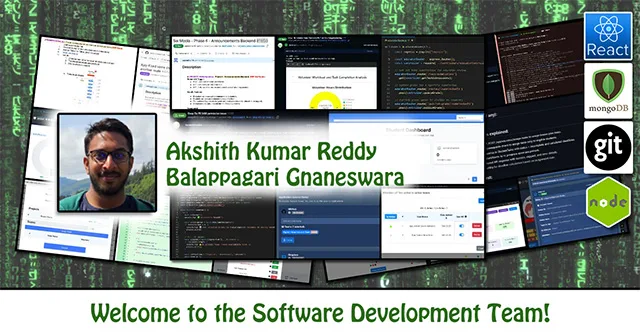
Akshith is a versatile software engineer who holds a Master of Science in Computer Science from California State University, Los Angeles. He is experienced in building scalable, user-focused applications using Java, Spring Boot, Python, Node.js, and front-end frameworks including React, Angular, and Vue. Akshith has expertise in developing RESTful APIs, optimizing backend systems, and creating data-driven solutions. Aspiring to grow as a data engineer and analyst, he is passionate about transforming raw data into actionable insights. As a member of the One Community team, Akshith has contributed to PR reviews and backend development tasks for the Highest Good Network Project, including designing and implementing the Student Tasks database, which enables structured task assignments, prerequisite tracking, and includes both educator- and auto-assigned workflows.
WELCOME TO THE TEAM AKSHITH!
FOLLOW ONE COMMUNITY’S PROGRESS (click icons for our pages)
INVESTOR PAGES
GET INVOLVED
One Community Welcomes Sree Pujitha Kakani to the Software Development Team!
Posted on November 13, 2025 by One Community Hs
One Community welcomes Sree Pujitha Kakani to the Software Development Team as our newest Volunteer/Consultant!

Sree Pujitha earned her master’s degree in Computer Science from the University of Central Oklahoma and has over five years of experience in software development. She enjoys creating scalable, user-friendly web and cloud applications that make a meaningful difference. Her work spans both front-end and back-end development, using technologies like ReactJS, Node.js, Java, Spring Boot, and AWS. As part of the One Community team, Sree Pujitha has helped improve the Highest Good Network software by adding new features, fixing bugs, and enhancing its overall performance. She developed the Engagement Tab (PR #4196) for the Event Management page, which incorporated the Comments and Feedback sections. These features support threaded discussions, replies, likes/dislikes, star-based feedback ratings, search, and sorting options, enabling organizers and participants to collaborate more effectively.
WELCOME TO THE TEAM SREE PUJITHA !
FOLLOW ONE COMMUNITY’S PROGRESS (click icons for our pages)
INVESTOR PAGES
GET INVOLVED
One Community Welcomes Koushik Chandra Katta to the Engineering Team!
Posted on November 12, 2025 by One Community Hs
One Community welcomes Koushik Chandra Katta to the Engineering Team as our newest Volunteer/Consultant!
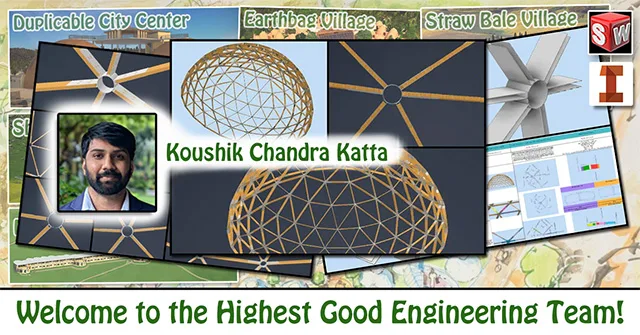
Koushik Chandra holds a master of engineering degree in Aerospace Engineering from the University of Cincinnati and has two years of experience specializing in Computational Fluid Dynamics (CFD), thermal simulations, and mechanical design. His professional background includes extensive work in structural and thermal optimization, applying analytical and design skills to projects focused on sustainability and performance enhancement. As a member of the One Community team, Koushik has contributed to the development of the Duplicable City Center by designing precision City Center Dome Hub Connector engineering, trimming and aligning structural beams, and performing thermal insulation studies to enhance energy efficiency. Through his work, he has helped further refine the dome’s mechanical integrity and thermal resistance.
WELCOME TO THE TEAM KOUSHIK!
FOLLOW ONE COMMUNITY’S PROGRESS (click icons for our pages)
INVESTOR PAGES
GET INVOLVED
One Community Welcomes Aseem Deshmukh to the Software Development Team!
Posted on November 12, 2025 by One Community Hs
One Community welcomes Aseem Deshmukh to the Software Development Team as our newest Volunteer/Consultant!

Aseem is a skilled Full Stack Developer experienced in building scalable web and mobile applications using React Native, Node.js, Spring Boot, Java, Python, and MongoDB. She holds a master’s in Information Systems from Northeastern University. Professionally, she has worked with NUUBI Inc., Birlasoft Ltd., and Meshbase Tech Pvt. Ltd., delivering solutions that enhanced efficiency, security, and user experience. As part of the One Community Highest Good Network software team, Aseem has contributed to code and PR reviews, worked on fixing bugs, and integrated the autoposter for Instagram and X platforms into the new UI, ensuring seamless functionality and improved performance.
WELCOME TO THE TEAM ASEEM!
FOLLOW ONE COMMUNITY’S PROGRESS (click icons for our pages)
 One Community
One Community